
In 2023, the Tesla Model Y wasn’t merely the world’s best-selling electric car – it was the most popular car, full stop.
No Taylor Swift tickets, then, for guessing that mid-sized SUVs have the most frenetic market activity of any EV category.
Audi, BYD, Polestar, Porsche, Skoda, and Volkswagen are all set to bring competitors to Australia later in 2024, but right now we have the first-ever electric cars from Ford, Subaru, and Toyota.
Ford has undoubtedly the most controversial nameplate, daring to trade on its V8 muscle-car heritage by calling its battery-powered crossover the Mustang Mach-E.
Subaru has gone all Latin with Solterra (a combo of ‘sun’ and ‘earth’), while Toyota has gone leftfield with the alpha-numerical bZ4X.
The Japanese brands’ EVs are more than mere architecture twins like the Hyundai Ioniq 5 and Kia EV6 platform buddies also in this group – they’re basically the same car with subtle design and spec differences.

While the bZ4X offers a $66,000 front-wheel-drive variant as one key difference, we’ve opted for the $74,900 bZ4X AWD for proper price and technical (near) parity with the top-line $76,990 Solterra Touring AWD.
We did, however, choose to split the Korean twins to give us the two different levels of performance available for both the Ioniq 5 and EV6. We have the $84,000 Ioniq 5 Epiq AWD and for our 2022 Wheels Car of the Year winner, we've got the $79,590 EV6 GT-Line RWD.
Ford’s Mach-E is available from $72,990 in base Select form, though we instead selected the mid-range Premium that’s still rear-drive and quite a jump at $86,990 before on-road costs, though it brings the biggest battery and biggest on-paper range to the group.
We also have the mid-range model of the car they would all dearly love to outsell – the $78,400 all-wheel-drive Model Y Long Range.
JUMP AHEAD
- Ford Mustang Mach-E Premium
- Subaru Solterra Touring AWD
- Toyota bZ4X AWD
- Hyundai Ioniq 5 Epiq AWD
- Tesla Model Y Long Range
- Kia EV6 GT-Line
- Winner
- Specifications
- Tested efficiencies
⚡ 2024 Wheels Best EVs
Looking for an EV in a different size or price category? Visit our full Wheels Best EVs series at the links below.
🔗 Wheels Best EVs
- Best Small Electric Car Under $40K
- Best Small Electric Car $40-50K
- Best Small Electric Car $50-60K
- Best Electric Small SUV
- Best Electric Midsize SUV
- Best Electric Midsize Sedan
🏅 OVERALL WINNER: Best Electric Car Under $80K
COMING SOON
- Best Electric Large SUV
- Best Electric Small Luxury SUV
- Best Electric Midsize Luxury SUV
- Best Electric Luxury Sedan Under $100K
- Best Electric Luxury Sedan Over $100K
- Best Electric Performance Car
🏅 OVERALL WINNER: Best Electric Car Over $80K
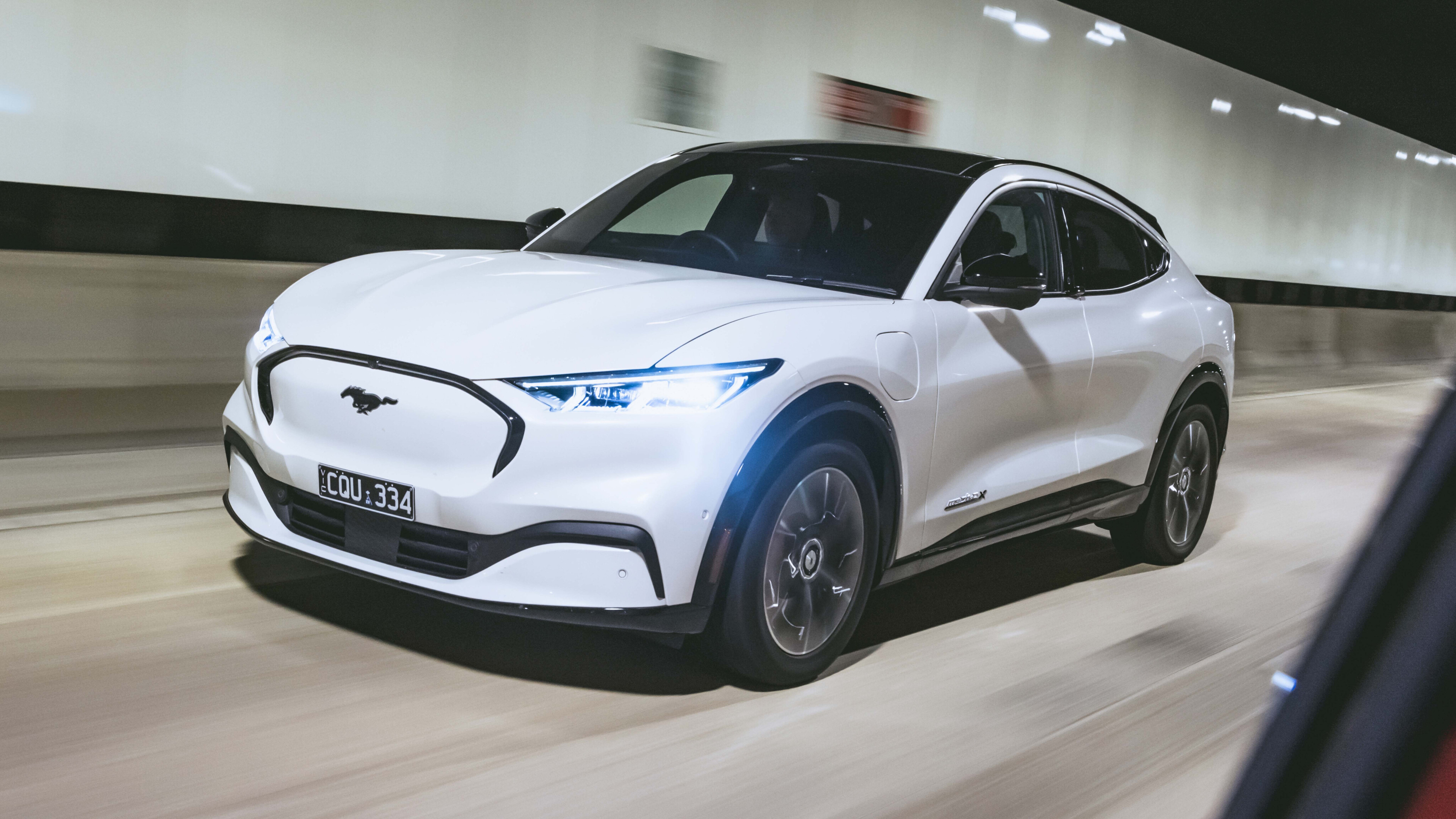
Ford Mustang Mach-E Premium
Oddly marketed Mach-E shines for range and curiosity
Ford’s newcomer, the Mustang Mach-E, makes a bold play for attention in the booming electric medium SUV category, wearing styling cues from the world’s best-selling sports car (somewhat awkwardly) and coming in swinging with a 358kW/860Nm GT AWD flagship that hauls itself from 0-100km/h in just 3.7 seconds.
As the brand’s first ground-up EV (albeit using a re-engineered ICE platform), the Mach-E is out to make a big impression and is instantly identifiable as a product of the Ford Motor Company – even though it doesn’t wear a single Blue Oval, which it eschews for stylised Ponies.
Fewer ponies in the paddock, though, because our budget didn’t stretch to the $104,990 GT AWD – so we settled for the mid-spec Premium rear-driver that offers 216kW/430Nm and falls inside the LCT threshold for efficient vehicles at $86,990 plus on-road costs, making it the priciest EV on test.
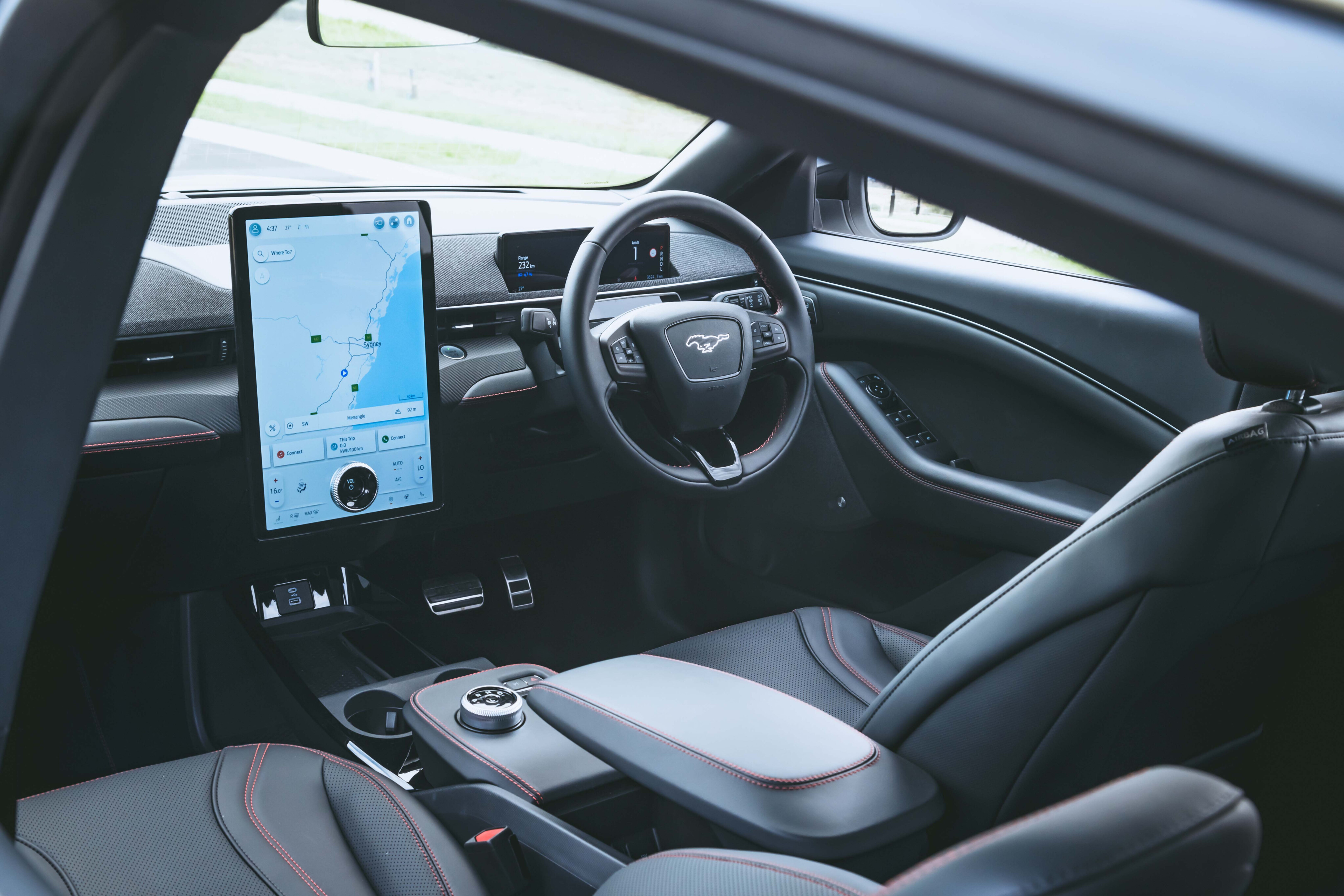
And that’s after a pre-launch price adjustment lowered Mach-E entry points by between $2675 and $7000, with the range-opener Mach-E Select benefitting from the largest cut to wear a $72,990 sticker.
Press a small, circular button on the window frame and the Mach-E’s driver door pops open – a tiny winglet providing the handle. (Rear occupants don’t get winglets and instead grab the door edge.)
A black-on-black cabin treatment makes for a dark vibe inside, though there’s a tinted glass roof letting light in (as well as heat, seeing as there’s no sunshade).
From red-stitched perforated-vinyl seats that look and feel flat (and are crying out for seat ventilation), front occupants are presented with an appealing mesh-fabric-upholstered upper dash (with matching door trim inserts) that evokes 1980s Alfa, with a swathe of carbon-fibre-effect trim below.
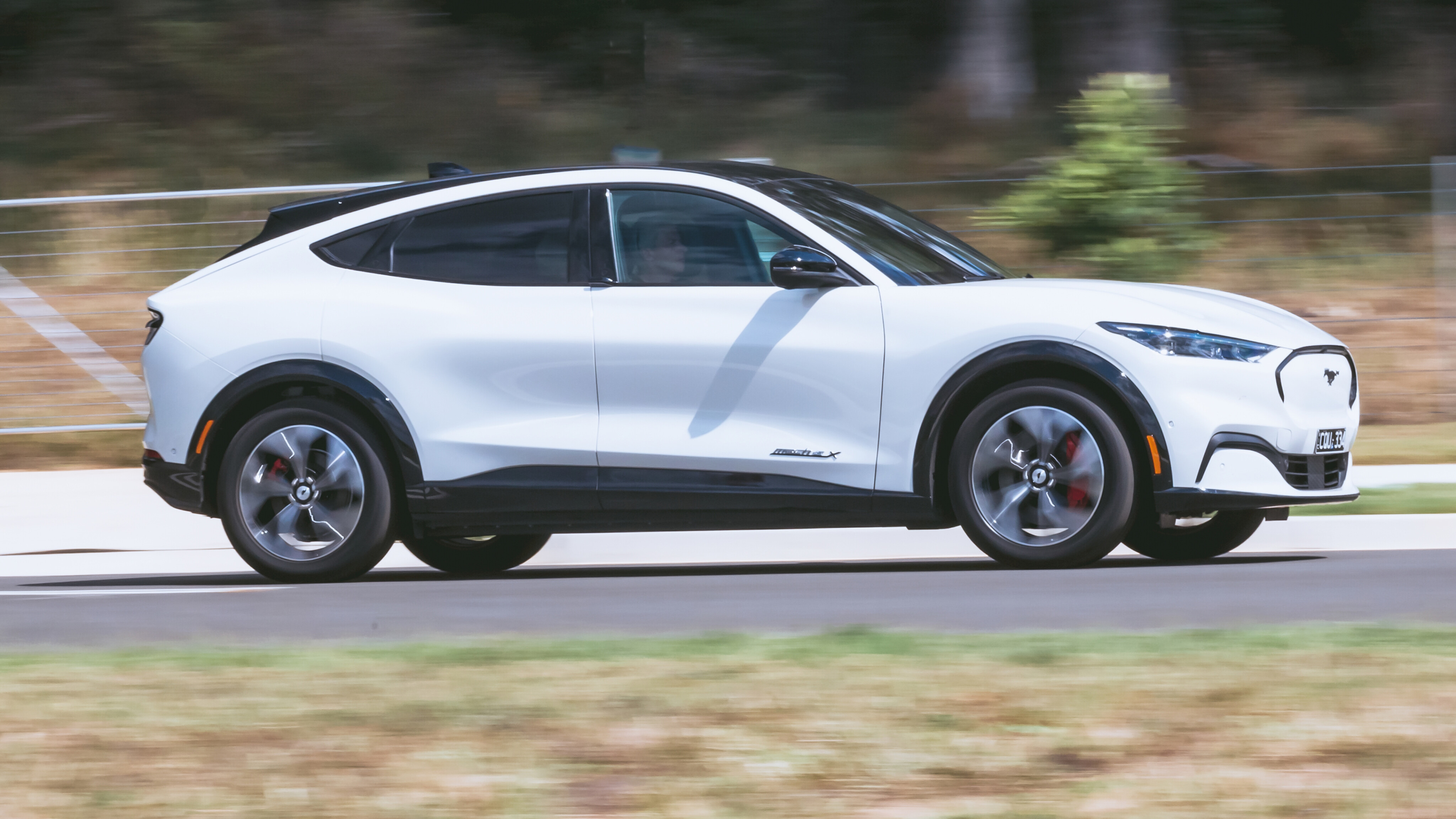
A Tesla-style 15.5-inch central portrait display screen and B&O audio also feature, with a dinky but functional cluster display and a nice leather wheel for the driver.
The rising beltline makes the rear equally dark, though forward vision is good, the bench is comfortable, and shoulder and leg room are great. There’s also central air-con outlets, plus USB-A and USB-C ports.
Back up front, the central display provides access to driving settings that make a big difference to how you get on with the Mach-E. With the level of braking regeneration tied to the drive mode, ‘Whisper’ allows for coasting while ‘Untamed’ brings heavier deceleration on a lifted accelerator, as well as an artificial propulsion sound that’s pretty unobtrusive, though it’s slow, gradual whirring would struggle to arouse anyone.

Thankfully, you can switch it off. There’s also a one-pedal mode – and it’s essential for avoiding the horribly grabby brake pedal in urban driving.
With its respectable outputs, the 2098kg single-motor Mach-E is good for 0-100km/h in a quoted 6.2 seconds. But it doesn’t feel quick off the mark – only gathering pace briskly above 30km/h – and the power delivery is a fraction grainy. It’s way off the pace of the Ioniq 5 and Model Y, feeling more the level of the less powerful Solterra/bZ4X twins.
The Mach-E’s rear-wheel drive and underlying balance brings an unexpected reminder of former local heroes, with an arse-out attitude attempting to introduce itself when punched from slower corners (before it’s quashed by the electronics), as well as roll-oversteer when punting the Mach-E one-up in faster corners.
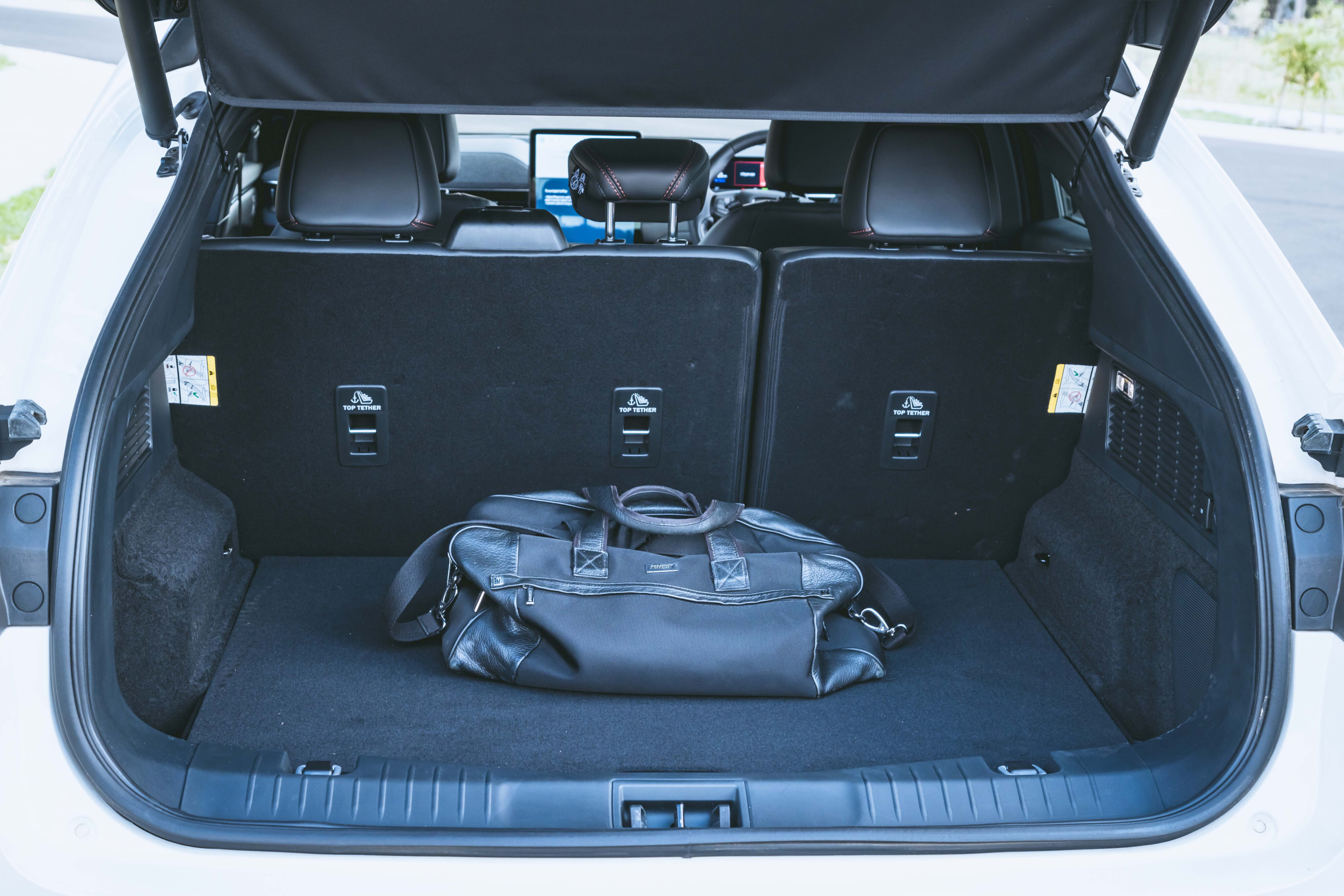
Low-speed urban ride is unsettled and, in these conditions, the steering gives up little communication.
With speed and cornering load, the wheel starts to suggest some classic Ford tuning nous, yet the Mach-E’s ride continues to buck occupants in line with its nameplate. Sharp-edged back road bumps intrude more than in any rival here, and jar through the steering; larger undulations are dealt with more adeptly.
In the absence of engine NVH, other sounds are seemingly magnified and the Mach-E’s combination of surface-dependent tyre noise, road vibrations, and wind rustle around the side mirrors will grow tiring on a trip.
The Ford holds an ace in its large-capacity battery, however – at 91kWh it’s 21 percent bigger than the next-best Tesla, which it rivals for real-world efficiency at 18.0kWh/100km.
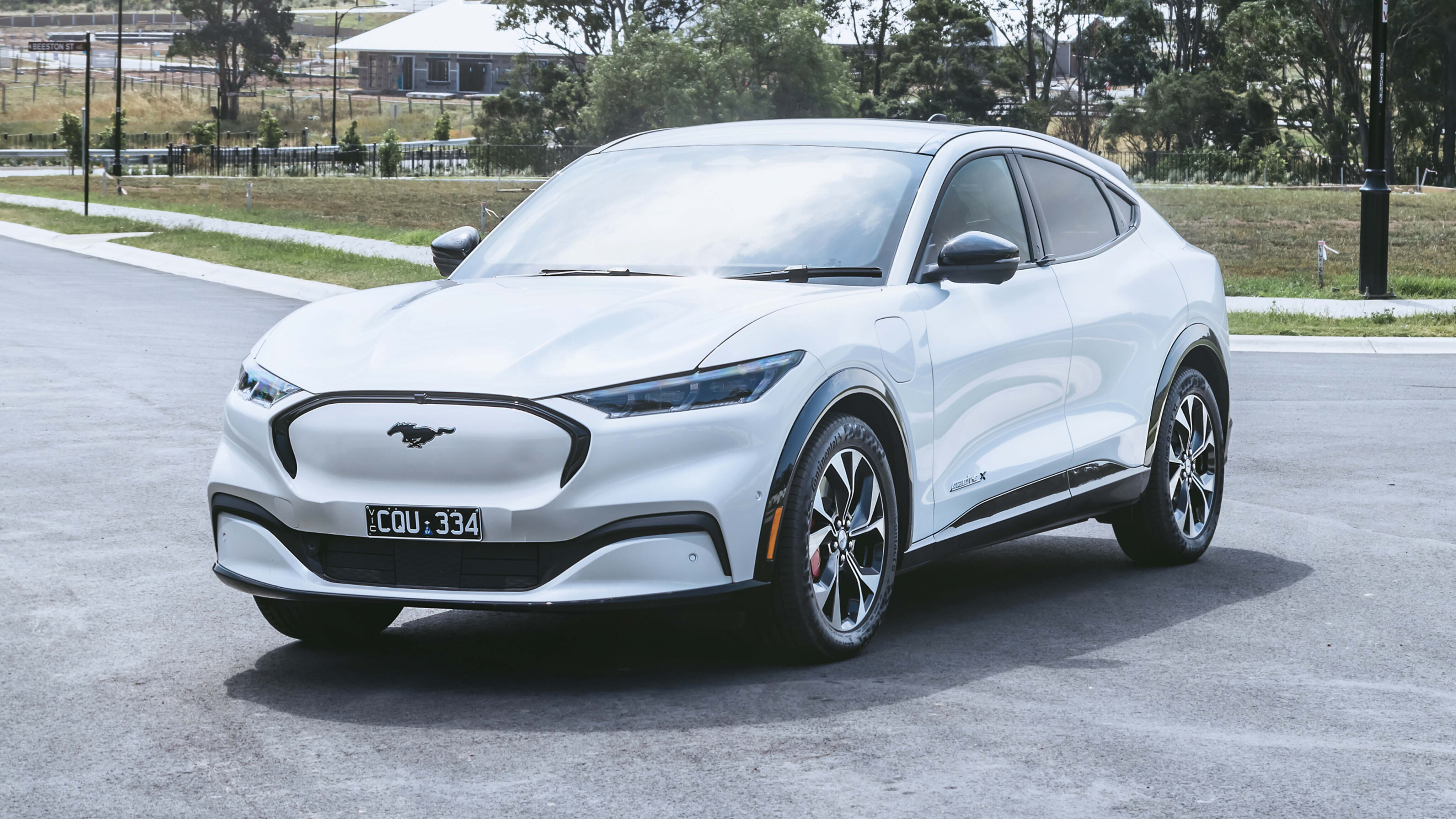
The result is the Mach-E will go farthest on a charge – our test indicated a range of more than 500km – but takes the longest to top up.
Efficiency is unlikely to be enough, though. The Mustang Mach-E is relatively pricey, with a polarising image – the retro cues desperately trying to evoke an emotional response the powertrain can’t.
The Mach-E is far more conventional than the futuristic Ioniq 5, and lacks the oomph of the Hyundai and Tesla, which make better driver’s cars and superior family wagons.
Meanwhile, the Kia EV6 is a better fit if the oddly specific brief calls for an 'SUEV' that channels the Pony Car.
James Whitbourn

Subaru Solterra Touring AWD
Twinning with Toyota doesn’t equate to a winning electric SUV
To drive the newly arrived Subaru Solterra and its sibling, the Toyota bZ4X, is to drive the same car … but for some subtle differences.
That’s true as tested, at least, with the $83,065 drive-away Solterra Touring AWD playing the $2854-cheaper bZ4X AWD with identical 160kW/337Nm dual-motor powertrains and broadly similar equipment.
It’s possible to have a $71,521 drive-away bZ4X front-wheel-drive, while the two-grade, AWD-only Solterra starts at $75,715 drive-away.
Brand loyalty may be the decider here, then, unless one of those subtle differences is a personal deal-breaker.
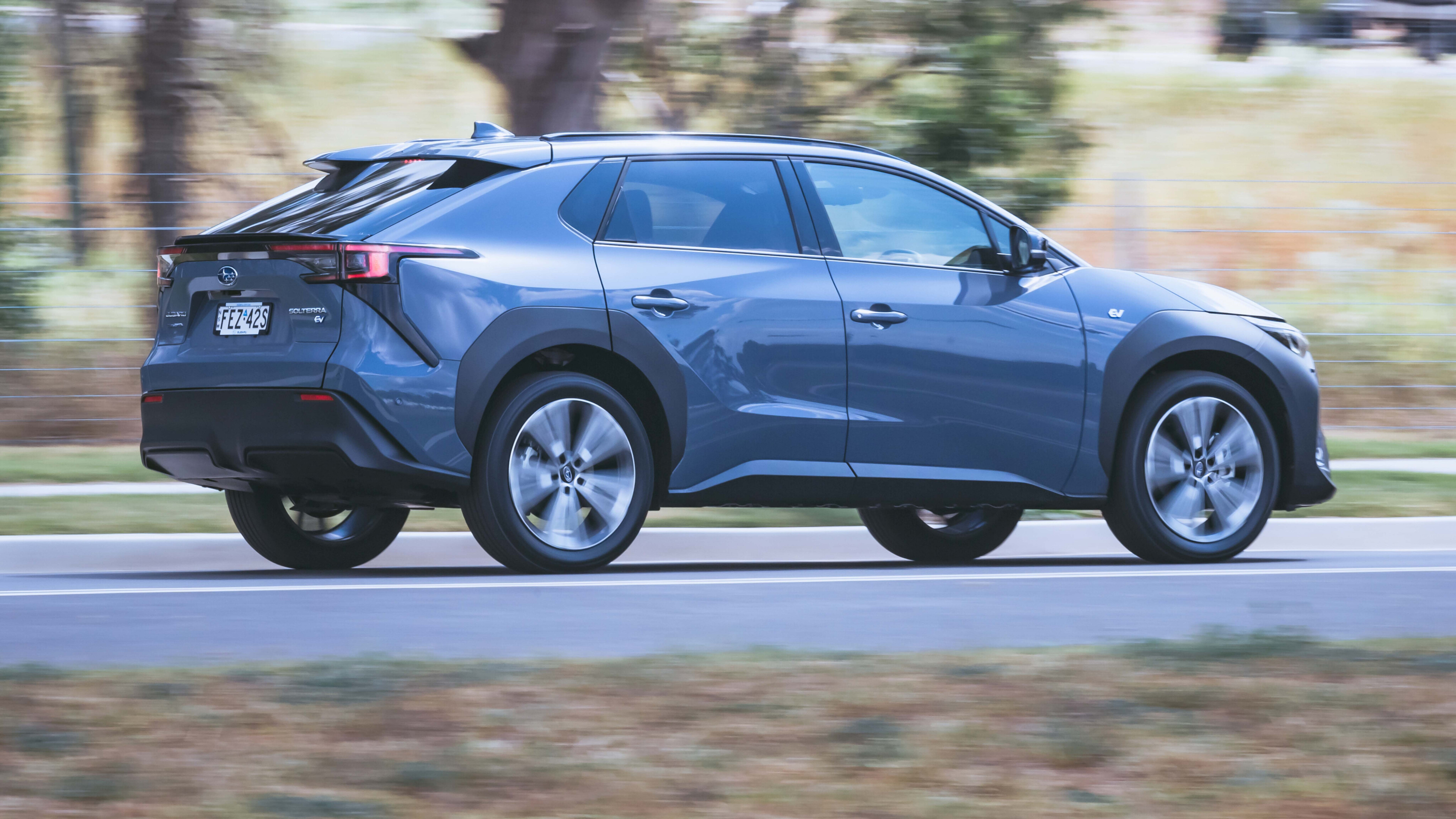
Not content to redefine the medium SUV as a pricey, battery-powered manga machine, the Subaru also reinvents the wheel – the steering wheel, that is, which features in flat topped and bottomed form.
Sure, it works stylistically against the backdrop of the Solterra’s ker-azy Japanese dashboard – complete with goofy yet functional 7.0-inch cluster display, upswept console, and 12.3-inch landscape centre screen. But the hand position it promotes leaves something to be desired – the Toyota’s round wheel.
In further differences, the Solterra Touring gets black synthetic leather while our Toyota tester brought the no-cost-option light grey. Our Solterra featured a powered passenger’s seat and rear-seat heaters; the bZ4X ventilated front seats with manual passenger’s adjustment (including height).
Finally, there’s a robust Harman Kardon audio in the former and JBL sound in the latter, while both have that new-Subaru smell.
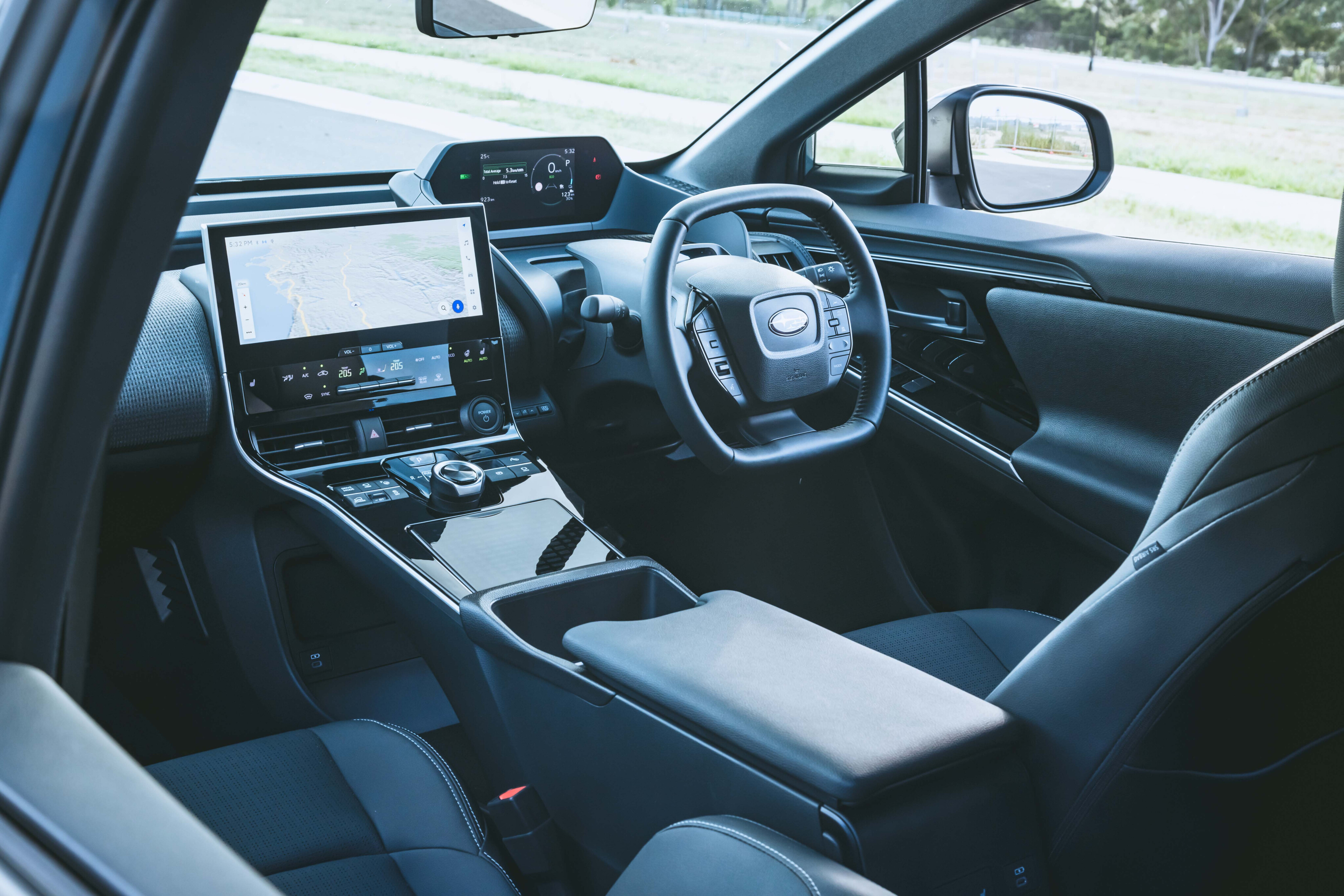
Further range-standard kit includes Wireless Apple CarPlay and Android Auto connectivity, navigation, LED head- and tail-lights, a powered tailgate, a heated leather steering wheel, dual-zone climate-control with rear outlets, and front and rear USB-A and USB-C ports.
There’s also extensive standard safety tech including AEB, radar cruise control and road-sign recognition, as well as front, side, curtain, and front-seat centre airbags.
The Touring grade adds to the base spec with 20-inch alloys, a panoramic glass roof, wireless Qi charging, and advanced park assist.
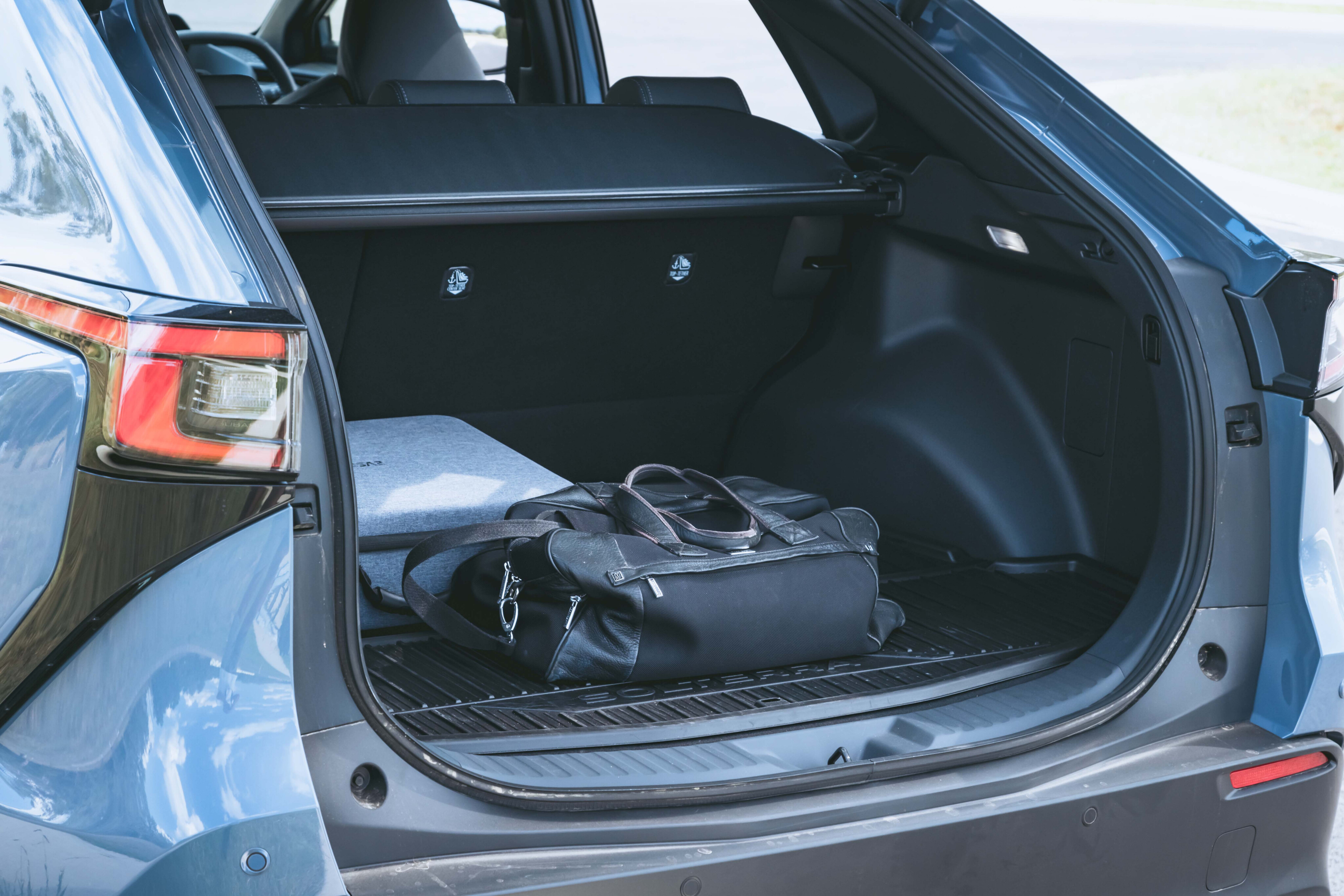
On the styling front, the test crew generally preferred the Toyota’s snout to the Subaru’s, which inexplicably looks like the Mustang’s. Perhaps there are only so many ways to not have a radiator grille.
Yet the drive experiences differ only in that the Subaru offers a noticeably livelier Power mode beyond both models’ Eco and Normal, and intuitive plus/minus column paddles to adjust the regenerative braking rate, rather than the Toyota’s centre-console button.
You quickly get used to the sensations of driving electrically, such as that faint buzz that follows you around, like you’re surrounded by a swarm of electromagnetically charged bees.
No synchronous motor will ever rival history’s great combustion engines for soundtrack, nor involvement, yet here you’re unlikely to miss the droning CVT and characterless four that would’ve had a run if global warming wasn’t a thing.

Although the two-tonne Toyobarus’ outright performance lags behind most rivals, it has every EV’s syrupy low-speed torque, and with a 6.9sec 0-100km/h time they’re swift enough. Once rolling, the pair have a nice vein of mid-range urge that makes them agreeable in the city.
Ask easy questions of Solterra’s chassis and it’s quick to respond with a well-damped urban ride and easy-going, Japanese-light steering. However, a back-road grilling that introduces higher speeds, greater cornering loads, and lumpier surfaces sees the Subaru stammer.
A reluctant nose is the overlying trait, while lateral loads fail to make their way to the steering wheel, which remains resolutely numb.
The ride, while not the last word in polish around the city, reveals a more obvious mismatch between the front and rear damping, with slower bump recovery from the front pointing to a slightly underdamped setting, and a lively rear suggesting a tad too much rebound.
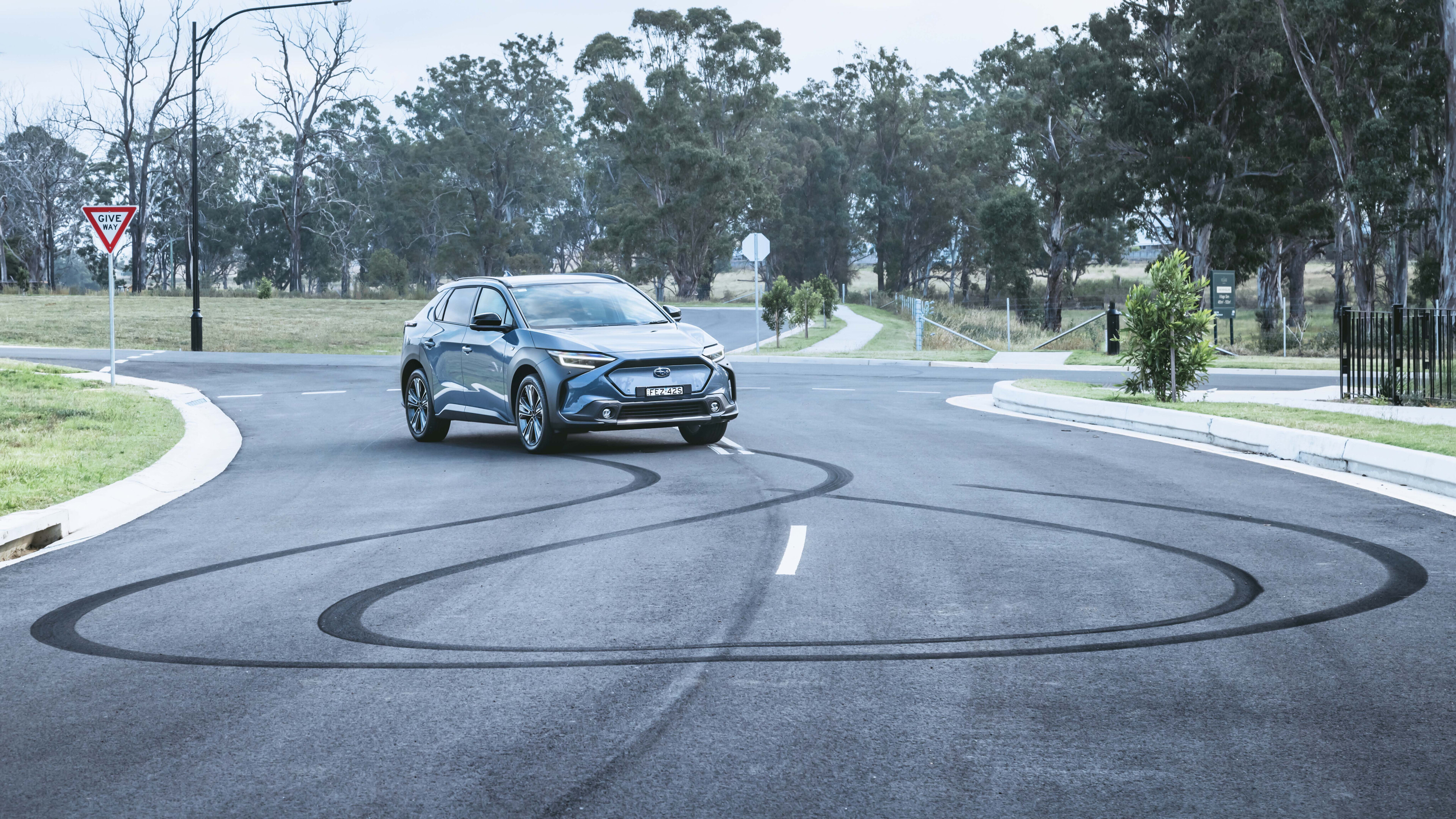
As well, there’s some tyre drone and some wind rustle around the side mirrors, though both are more muted than in the Mach-E.
Country driving reveals a further shortfall. With the smallest battery here (at 64kWh usable) and a relatively high tested energy consumption – despite only modest performance – the Solterra (like bZ4X) provides a real-world range of just under 350km. (Subaru quotes a range of 485km on the NEDC test, which is more generous than the now industry-standard WLTP.)
Factor in the 150kW maximum DC fast-charging capability – to charge from 10-80 percent in a claimed 30 minutes – and the Subaru is also on the slower side to fill its cells.
We can appreciate that the economics of EV development and manufacturing mean this is an expensive product. But no maker can afford to leave so much on the table while asking customers to part with more than $80K for a five-seat electric SUV.
Or, to put it as one tester did: do you want an electric Forester that much?
James Whitbourn

Toyota bZ4X AWD
Safe, sturdy and quietly punchy, though lacking any X-factor
Sharing development costs is nothing new for Toyota and Subaru. They’ve been doing it for more than a decade now with two generations of 86/BRZ coupes, so following the same principle with the first-ever EV for each brand clearly made a tonne of sense. Make that two tonnes.
Externally, the styling differences between the EVs are greater than 86/BRZ, with Toyota’s bZ4X arguably clinching victory over the fussier Subaru Solterra thanks to its smoother front-end, black-accented (same-design) 20-inch alloys, and cleaner tail-lights with a red light band spanning the width of its (electric) tailgate.
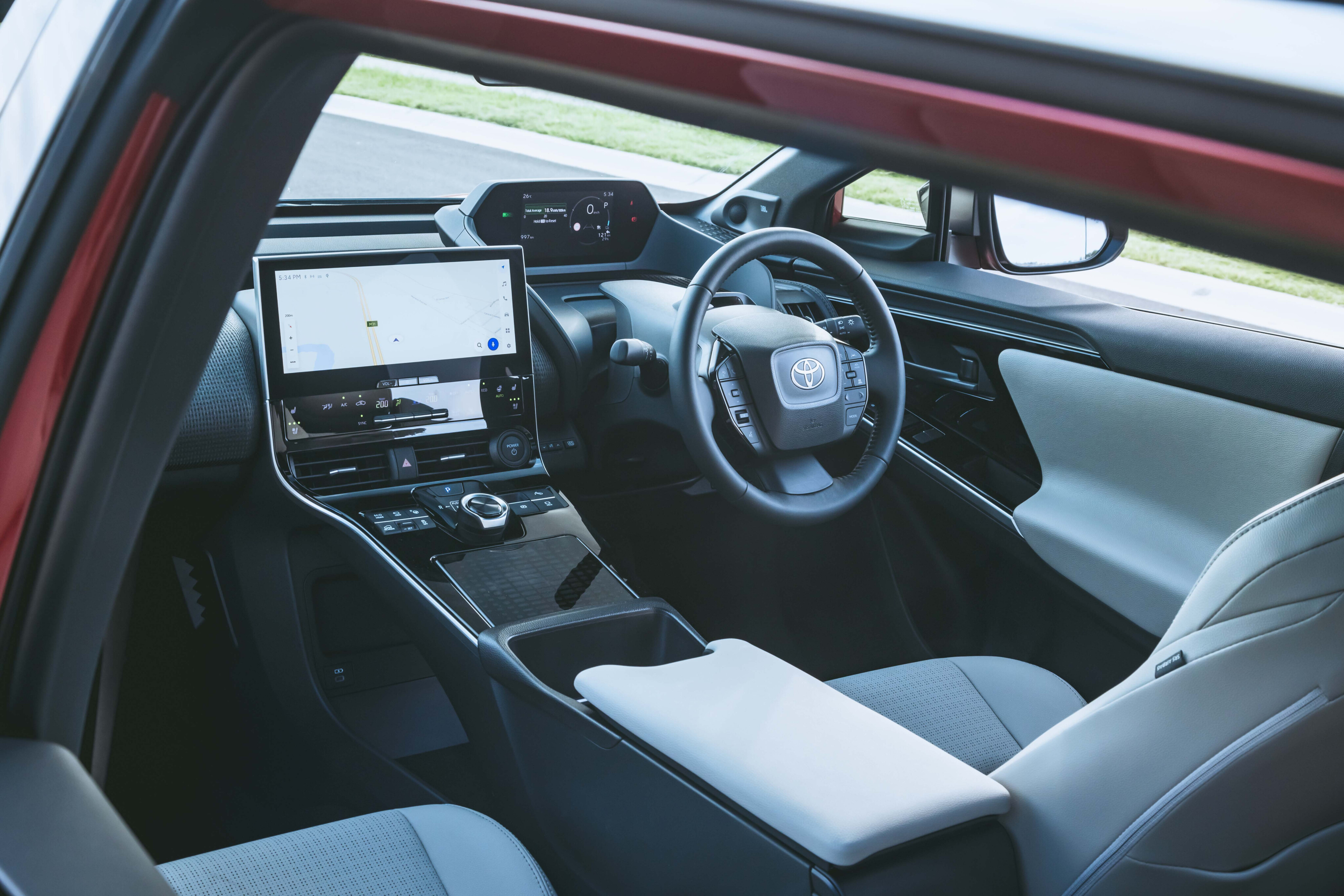
Inside, the bZ4X AWD uniquely includes a round steering wheel and a ‘greige’ colouring to its synthetic-leather perforated seating and door trims that lightens the cabin mood considerably, though the exclusive front seat cooling whispers its effect rather than blows – even on maximum.
They share rear-seat USB-C ports, but the bZ4X misses out on the $2K-dearer Subaru’s wheel-paddle-adjustable regenerative braking (it’s simply on or off in the Toyota), and its one-pedal mode also works in name only, given that it can’t stop the car and doesn’t provide much braking retardation.
Unlike both generations of 86/BRZ, however, the bZ4X and Solterra are identical under the skin, meaning not only the same driveline and electrics (reportedly developed by Toyota) but also the same suspension tune (reportedly honed by Subaru).
And what that delivers is an unexceptional EV that feels solid and rides with a degree of firm authority (despite considerable tyre noise and surface sensitivity), yet lacks finesse in almost all areas and, perhaps consequently, any character. A base Corolla would drive rings around a bZ4X.

Chief offender is the steering, which feels heavy-ish when parking but light and numb at speed, as well as leisurely in its response when deviating from straight ahead – the polar opposite of the ultra-keen Tesla Model Y.
The only saving grace is the bZ4X’s round steering wheel, which partly obscures the (basic) digital instruments but at least avoids the perpetual irritation of the Subaru’s heavily squared-off version.
The Toyobarus seem disinterested in changing direction and, while they display neutral handling balance when set up properly in a corner, they’re clearly front-biased, with both front wheelspin and power understeer rearing their ugly heads at times, despite being AWD. And it’s here, more than anywhere, that the Japanese EVs feel significantly inferior to their Korean and American alternatives.
At least the Toyota AWD’s electric drivetrain has its appeal, with a strong surge from a standing start and a 0-100km/h claim of 6.9sec (compared to 7.5sec for the bZ4X front-driver).
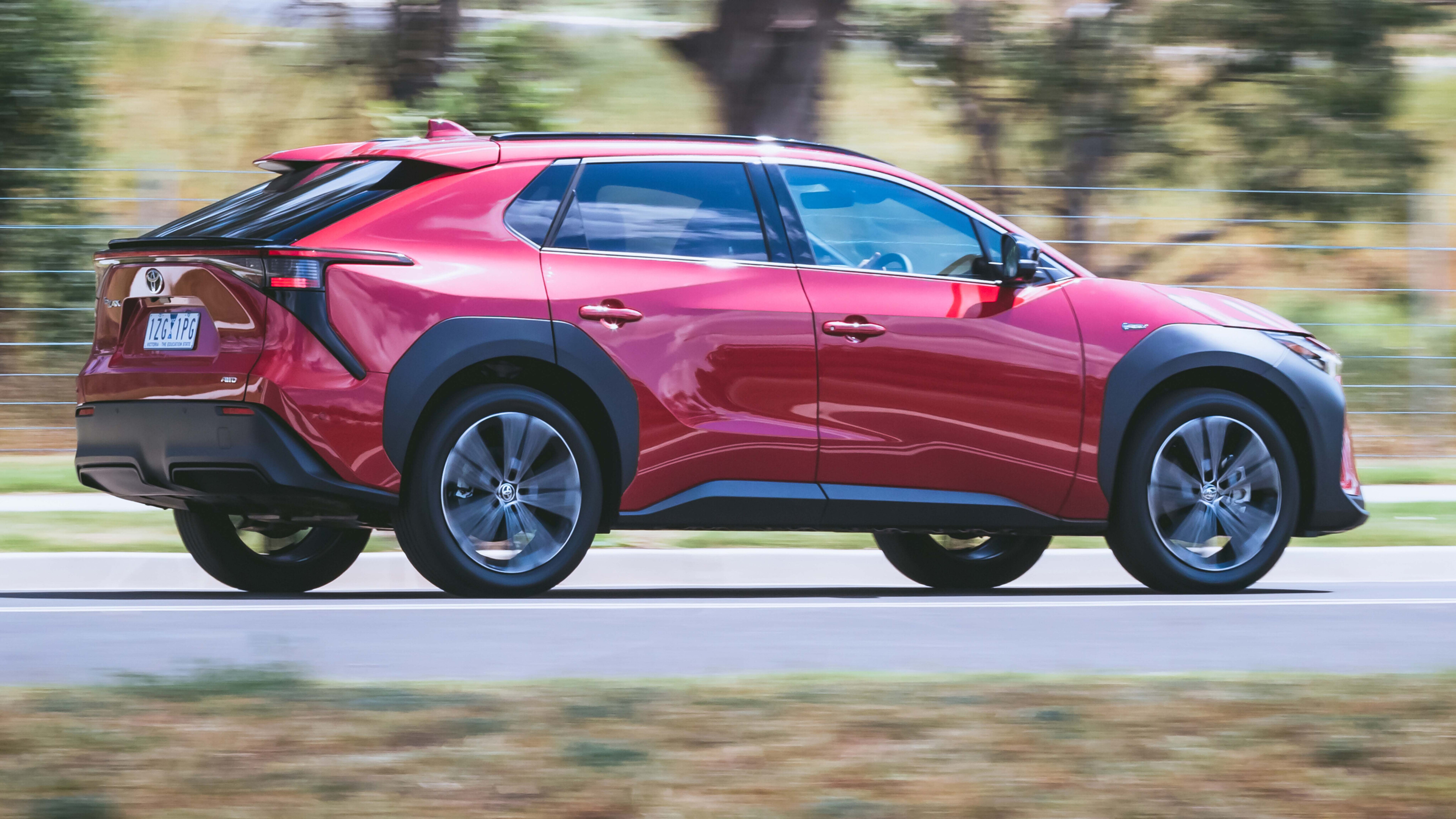
Featuring a 64kWh (usable) lithium-ion battery and an 80kW/168.5Nm electric motor on each axle, Toyota claims a 10-80 percent charge time of 30 minutes at the maximum DC capacity of 150kW, which is competitive with cheaper EVs but well below the standard of the Hyundai and Kia.
Toyota also claims a combined WLTP energy consumption of 18.1kWh/100km, which is close to our 18.6kWh/100km test figure.
The bZ4X AWD’s range claim (WLTP) is a fairly average 411km, though the real-world range from our testing calculated to 344km, giving the electric Toyota the stumpiest capability on a country journey by just 2km from its Subaru Solterra twin.
On these adventures, you might notice that the designers have tried to give the bZ4X some interior sparkle, with meshed cloth dashboard trim, a classy 12.3-inch centre touchscreen, a reasonably impressive JBL stereo, a modest digital instrument pod mounted Peugeot-like above the steering wheel (in theory), and mostly sensible switchgear, as well as the aforementioned two-tone colour treatment.
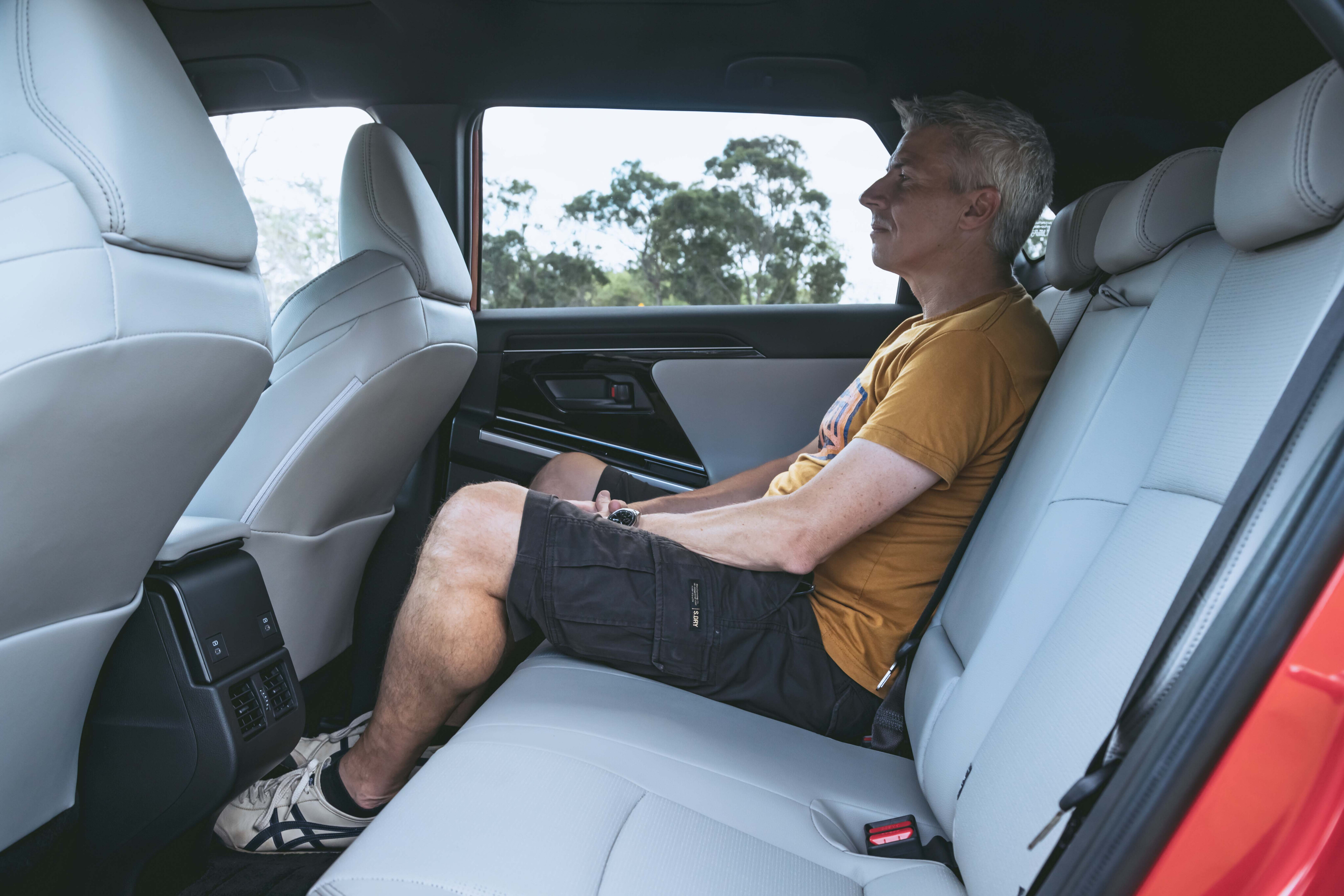
The seating is comfortable, front and rear – though lacking in rear under-thigh cushion support – and cabin space is competitive, but the detailing falls well short of what you’d expect for a list price of $75K.
For that kind of money, the bZ4X’s hard plastics, modest door storage, weirdly separated glass roof (it’s a single pane but has a headlining bar inserted across the middle), and cheap-looking instrument graphics are exposed. This is no Polestar rival for cabin slickness, let alone Hyundai’s designer-chic Ioniq 5.

If you approach the Toyota bZ4X AWD pragmatically, it’s inoffensively appealing. It seems well-equipped, appears intriguingly different to a Corolla or Yaris, and costs just $180 a year to service.
We’re sure the bZ4X will provide painless, effective, and satisfying ownership for many customers – supported by the largest dealer network in the country.
But for a first-ever EV attempt this late in the game, we hoped for more from the bZ4X. It seems to be relying on the loyalty of Toyota’s ownership base rather than trying to introduce something fresh or interesting to the category. For the asking price, there are better, classier alternatives.
Nathan Ponchard

Hyundai Ioniq 5 Epiq AWD
Timeless design meets great packaging and performance
Remember when car designers thought that a pukka Hybrid should somehow look like a Hybrid, and an EV should, for some reason, be slightly weird without being attractive or genuinely cool ... aside from the decade-old, still-handsome Tesla Model S?
In more than any other area, the Hyundai Ioniq 5 has broken the mould for automotive design, in a way that EVs from many legacy manufacturers (such as Mercedes-Benz) have failed at spectacularly.

Ultra-modern yet intriguingly retro and wonderfully individual, the Ioniq 5 ranks among the handful of 21st-century designs that can truly be labelled ‘instant classic’.
But styling alone isn’t enough to make a car – not in a Wheels comparison test anyway. Thankfully for the Ioniq 5, Hyundai seems determined to keep finessing its now three-year-old icon – turning what was already a quite impressive thing into something potentially even better.
Come mid-year, the Ioniq 5 gets comprehensively upgraded with a larger battery (84kWh versus 77.4kWh for this MY24 model, and Kia’s related EV6) for expanded range, a sportier N-Line variant, a stronger body structure, improved suspension tuning and noise isolation, re-engineered switchgear, revised infotainment, enhanced active-safety features, new bumpers and new wheels for MY25.
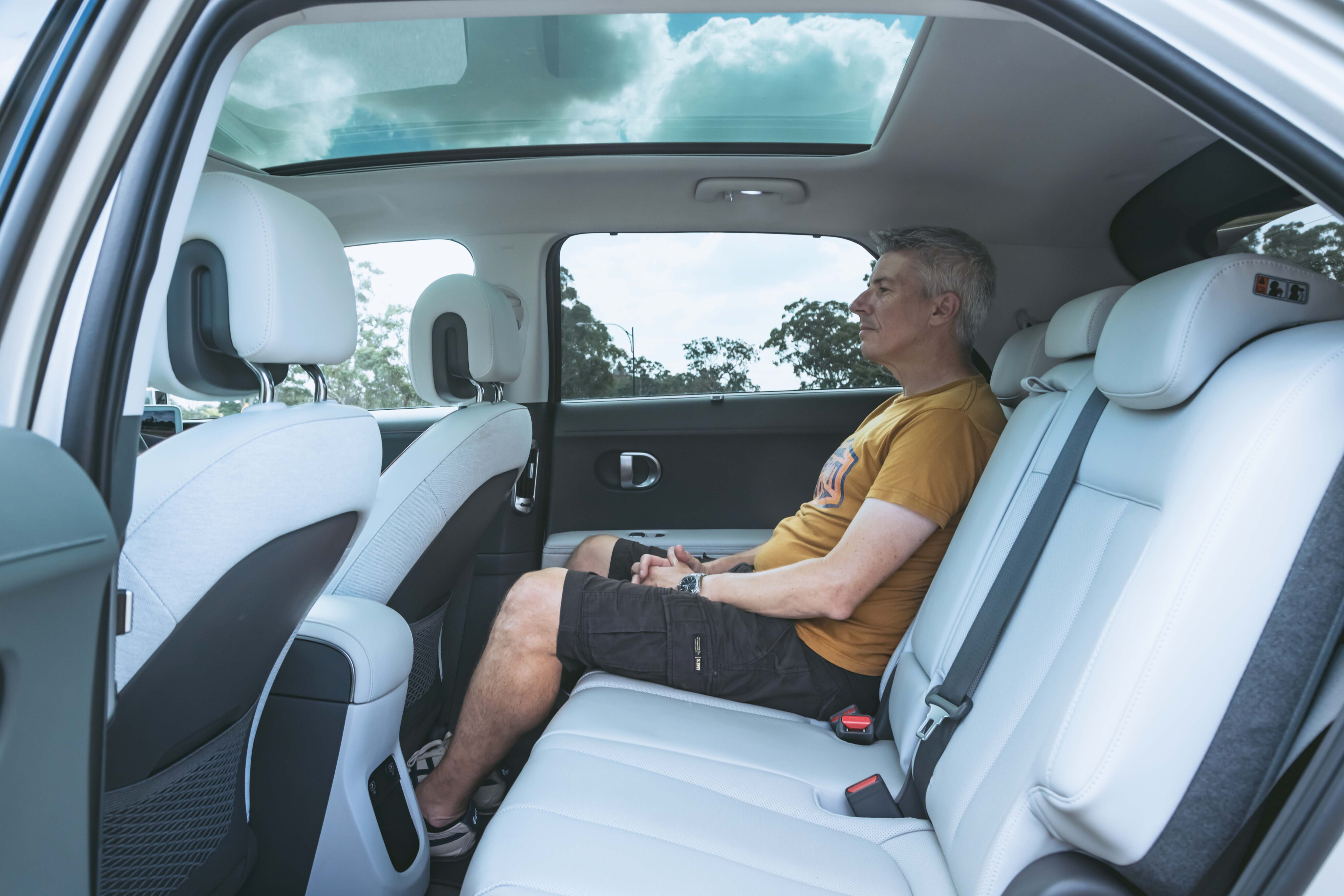
We must applaud Hyundai for its perpetual desire to make the Ioniq 5 better, because many of those ‘revised’ areas mentioned are exactly where the MY24 model stumbles.
Not to any large degree, but enough to warrant further investigation – particularly its ride. While the 239kW/605Nm Ioniq 5 Epiq AWD is a hoot to hustle thanks to its superb grip, rear-biased handling balance, keen steering response and tremendous performance, its ride quality often sees it lolling about … in a somewhat charming way because it isn’t too discomforting, especially on smoother roads. It’s just not finessed.
Following an initially fairly terse primary ride, the Ioniq 5 will easily absorb big lumps at urban speeds – better than any EV here.
But this underlying plushness leads to it being underdamped at speed, where the lack of compression damping sees the Hyundai nudge its bump stops quicker than its rivals, with recovery also a little lax.

It does all this in a smooth-edged fashion, but that contrasts starkly with the Kia EV6’s well-controlled firmness and level demeanour. If there’s one word you’d never use to describe the Ioniq 5’s ride, it’s ‘level’.
The Hyundai’s premium interior is a much classier, more expensive-looking and feeling place to spend time than the Kia’s (and its competitors), yet the flat 12.3-inch screens and hidden switchgear (the seat heating and cooling are buried in the centre touchscreen, for example) highlight its prioritising form and cost-savings over function.
That said, the MY25 model moves those controls, plus the wireless charging pad, to the centre ‘island’ between the front seats – much like the EV6 – for improved functionality. And the Ioniq 5 beats the EV6 for cabin lightness. Its low beltline and brilliant all-round vision make it a joy to drive simply for the view.
In the Ioniq 5 Epiq AWD, there’s also a glass roof with an electric sliding blind that protrudes from both ends before meeting in the middle – giving it the glassiness of the Tesla combined with proper sun protection on hot days.
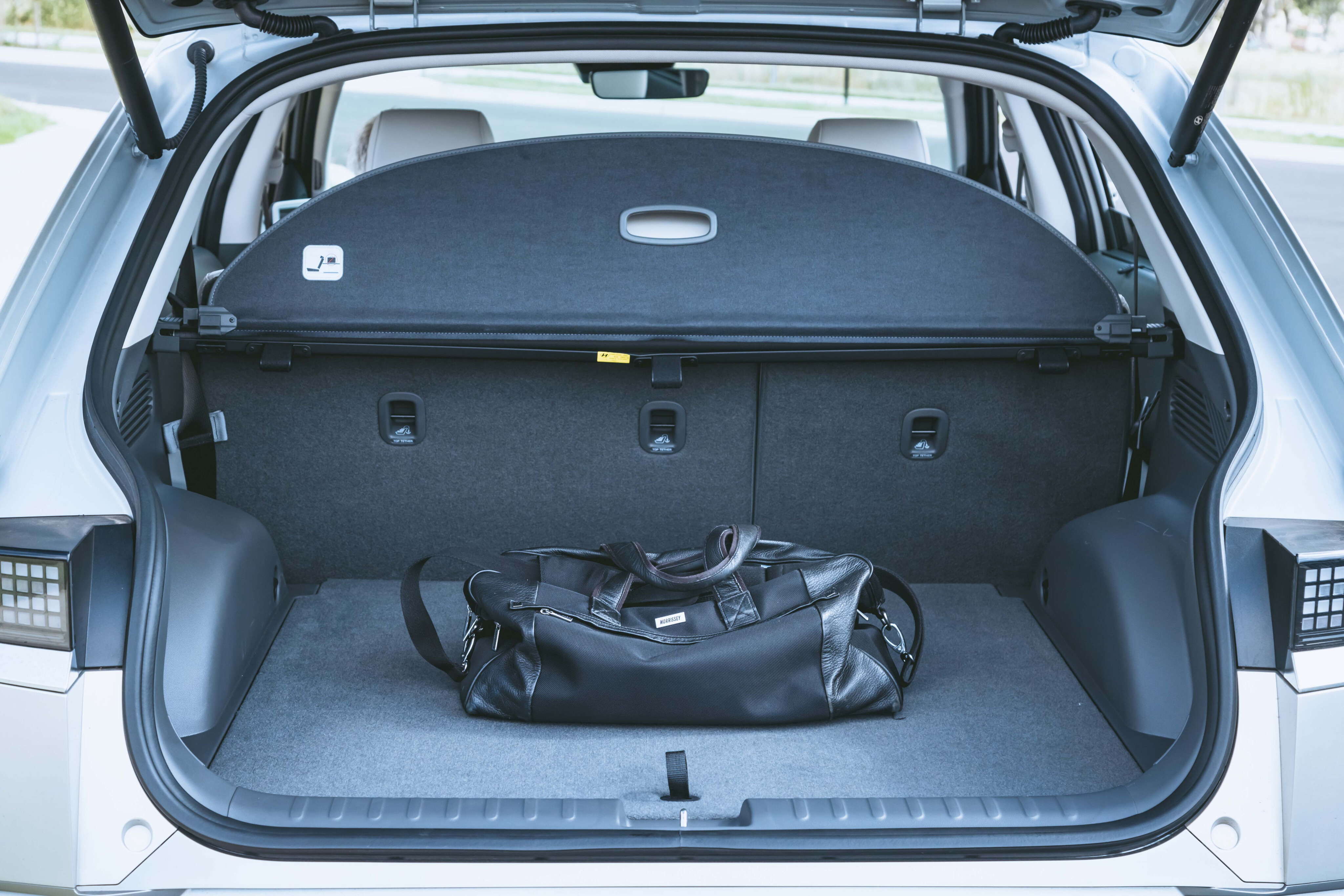
And while the same could be said about the Toyobarus, their curious centre beam robs their cabins of true airiness.
The Hyundai also offers some unique features such as camera-operated rear-view mirrors (which you do become accustomed to) and ‘Relaxation’ front seats that tilt backwards and have ottoman extenders for a quick, comfy nap while charging.
Speaking of which, it does so just as quickly as the Kia, taking 18 minutes to charge from 10-80 percent, while suffering little in real-world range (392km according to our testing and maths), despite its searing 5.2-second 0-100km/h acceleration.
The WLTP claim is 454km, so perhaps the AWD variants of Ioniq 5 and EV6 actually make more sense given their huge performance lift – especially when punching out of corners.

Where the rear-drive Kia squeals its Continentals and ignites the ESC (unless you disable traction control), the lusty Ioniq 5 AWD hunkers down on its Michelins and charges ahead.
Judging by the extent of its forthcoming updates, I think the best is yet to come for the non-N Ioniq 5. But even as assessed here, it’s an interesting, rewarding and well-equipped EV.
If the MY25’s proposed improvements prove successful, the Ioniq 5 could place even higher in a future similar comparison, even with its comparatively small boot (versus the Tesla’s gaping cavity). That’s how good the rest of this design icon still is.
Nathan Ponchard
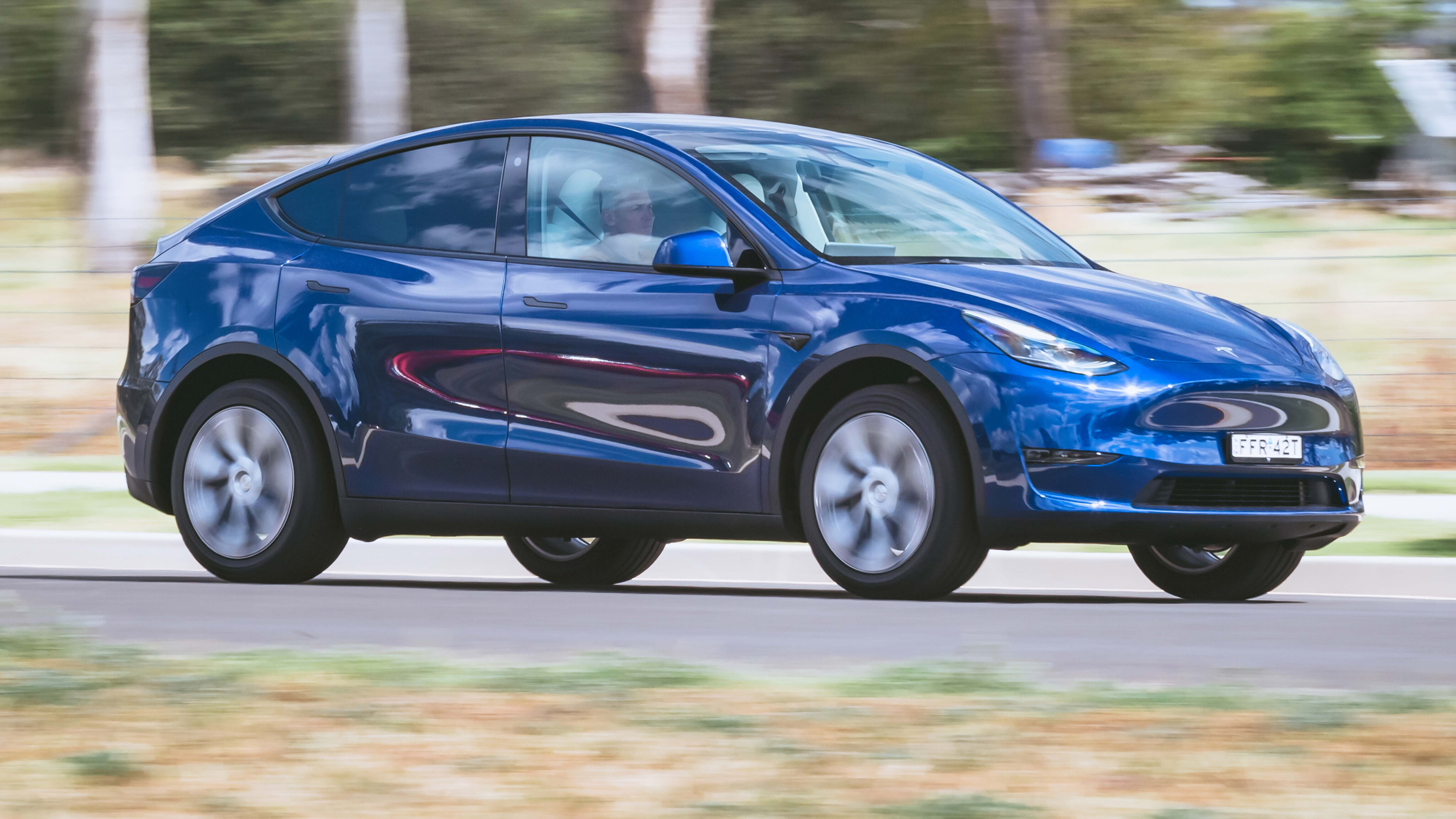
Tesla Model Y Long Range
Ubiquitous ev combines popularity with genuine ability
The coupe-crossover carves keenly into the long left sweeper, settling onto its outside tyres with a neutral mid-corner attitude before riding a syrupy tidal wave of torque from apex to exit.
We haven’t previously been that enamoured with the Model Y’s dynamics, tested earlier in base RWD and flagship Performance guises, yet the ride and handling of the mid-spec Long Range is proving to be surprisingly good – at least on our long country test loop.
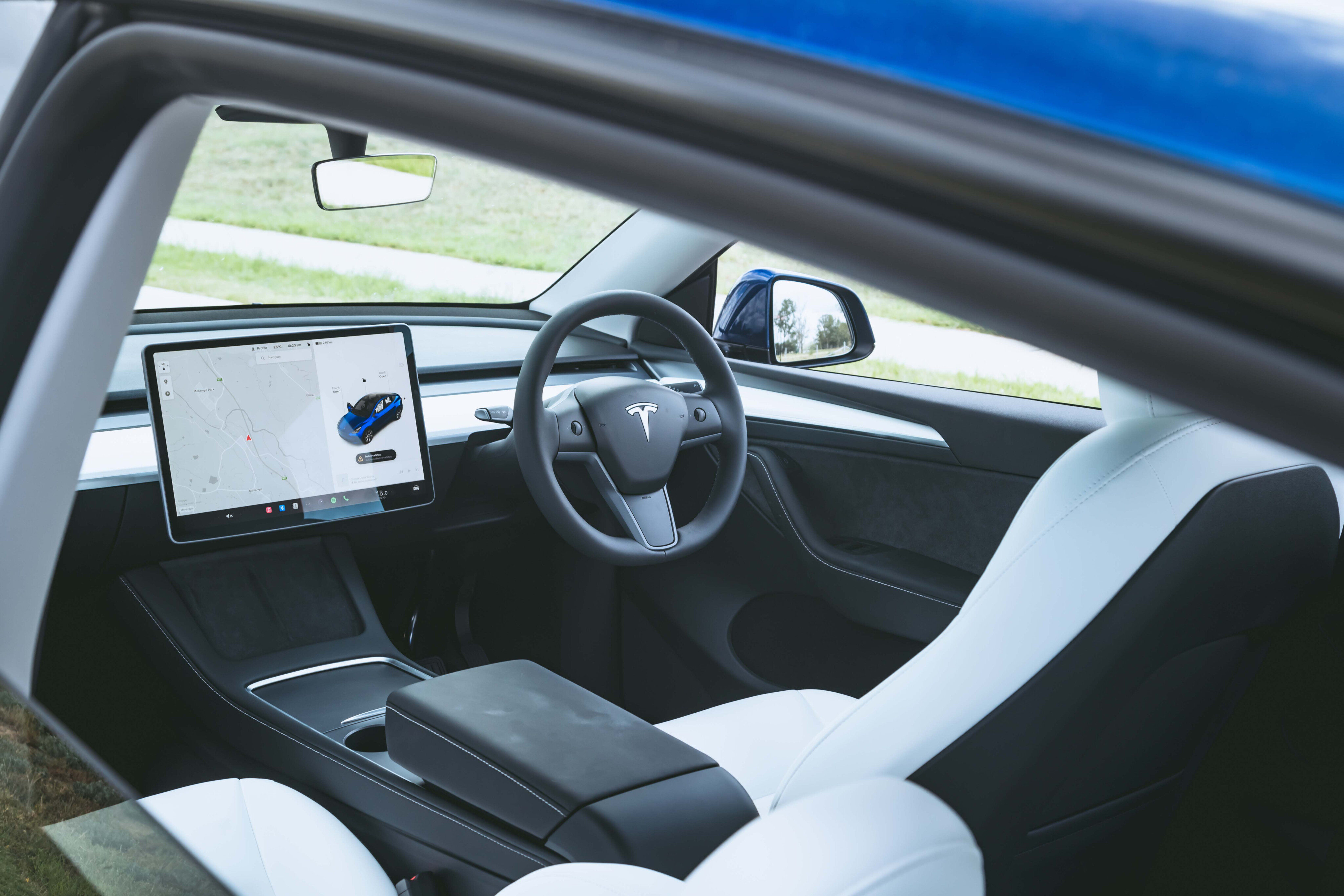
We’d love to explain why this variant seems better to drive, but it would be easier to stage our own mission to Mars in a SpaceX rocket than extract specific information out of Tesla.
It’s almost impossible to escape Australia’s best-selling electric medium SUV, probably in ubiquitous Deep Blue like our test car – in a traffic jam, at the shopping centre, or in your neighbour’s driveway. The Model Y was private Aussie buyers’ favourite car in 2023.
In this trim, it produces 286kW and 510Nm unofficially (did we mention that Tesla is not big on providing specs), does 0-100km/h in a claimed 5.0sec, and unofficially draws from a 75kWh (usable) nickel-manganese-cobalt (NMC) battery to provide a claimed WLTP range of 533km. Our testing suggested a real-world 424km.
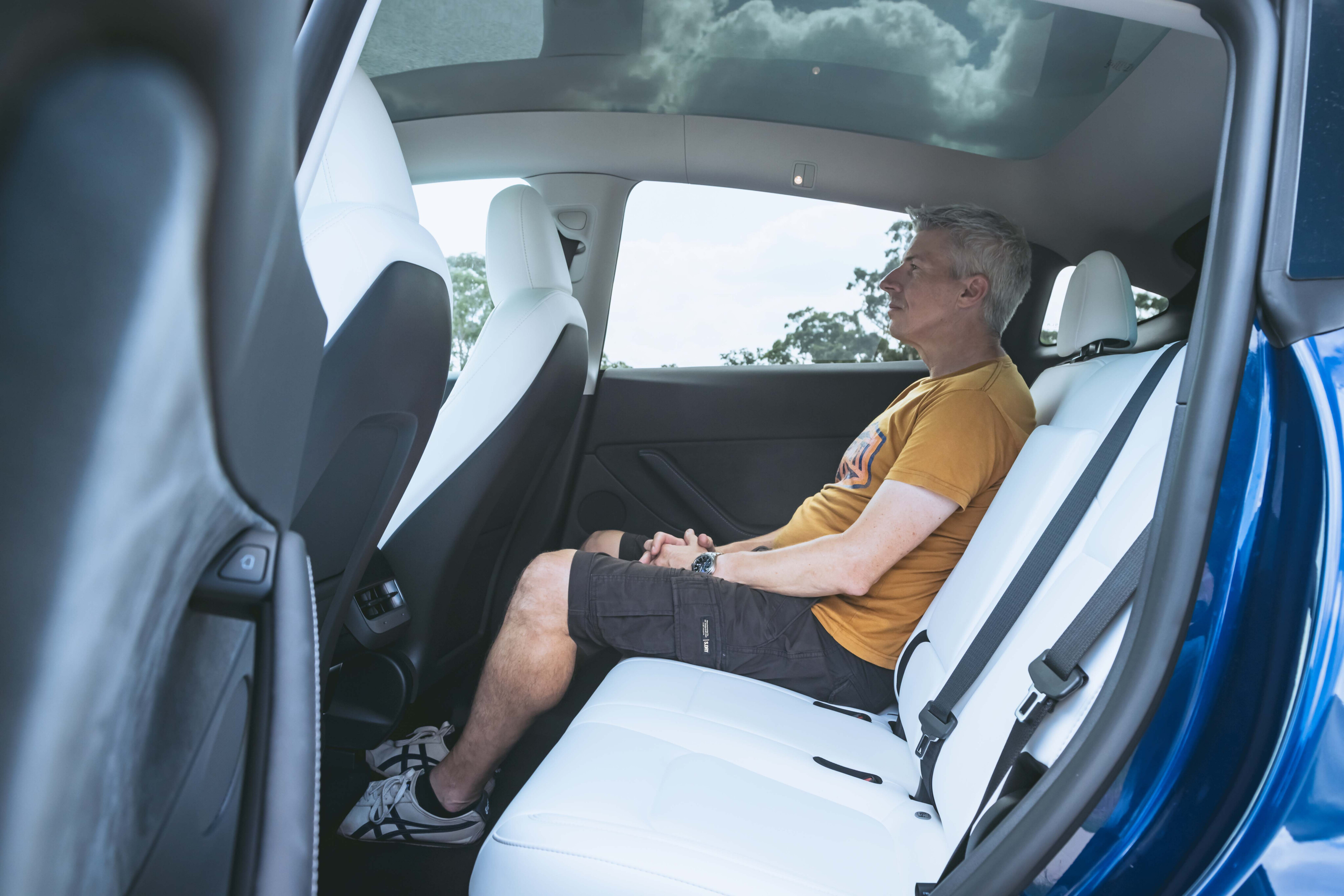
Taking advantage of 250kW DC fast-charging capability, the Model Y is said to add 261km of range in 15 minutes, and our pit stop at a suburban Sydney Supercharger suggested this claim is on the money.
Highly equipped from the $65,400 (plus ORC) rear-drive range-opener, North America’s Shanghai-built SUEV brings a 15.0-inch touchscreen display, dual wireless smartphone charging, a glass roof, synthetic leather, a 13-speaker sound system, powered front seats, heated seats and steering wheel, powered tailgate, a dashcam, and 19-inch alloys.
To this, the $13K-pricier Long Range adds dual-motor AWD and … LED fog lights. Our tester came in extra-cost Deep Blue Metallic (of course) with a white interior for $1500 apiece.
On the safety front, every Model Y packs seven airbags including a front-centre unit, and safety tech such as AEB, blind-spot assist, lane-keep assist, reverse and side-view cameras, tyre-pressure monitoring, automatic high beam, and an intelligent speed limiter.
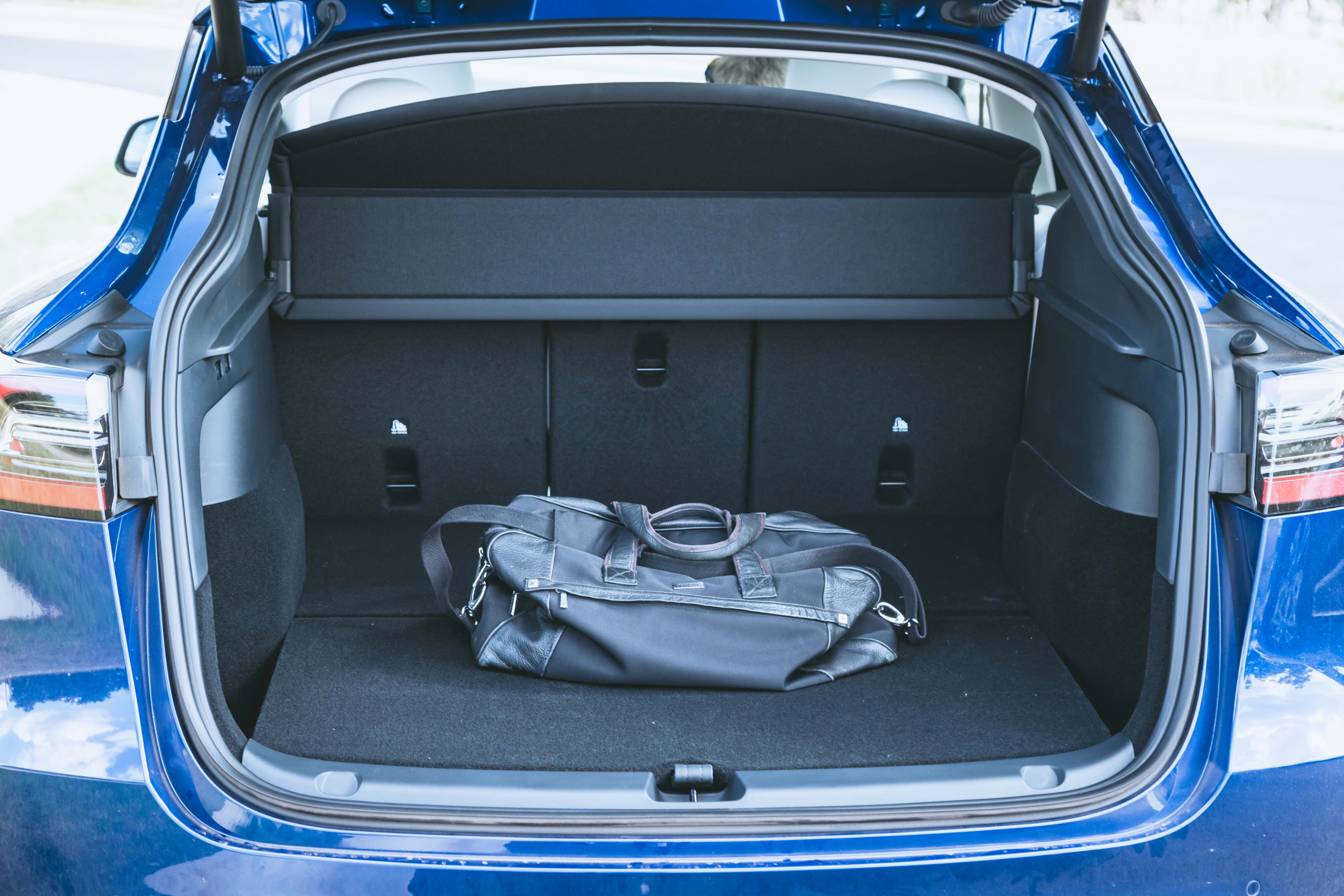
The Tesla offers out its neat flush door handles by way of an introduction and, with the brand’s reputedly rising build quality, they’re increasingly unlikely to come off in your hand.
Cool frameless door glass provides a fleeting nostalgia hit because, from here on in, futuristic minimalism pervades.
The brand-signature central infotainment display dominates the cabin by virtue of its sheer size, and the fact you need to interact with it to do anything in a Model Y. The Tesla’s is certainly not the most intuitive interface if you’re fond of, say, wiper stalks or climate-control buttons, but it may be okay if you were raised by an iPad.
Think of the whitest thing you can, then add a bottle of White King, and you have the Y’s optional upholstery. It’s bright! And highly unlikely to hold up to the ravages of family life.
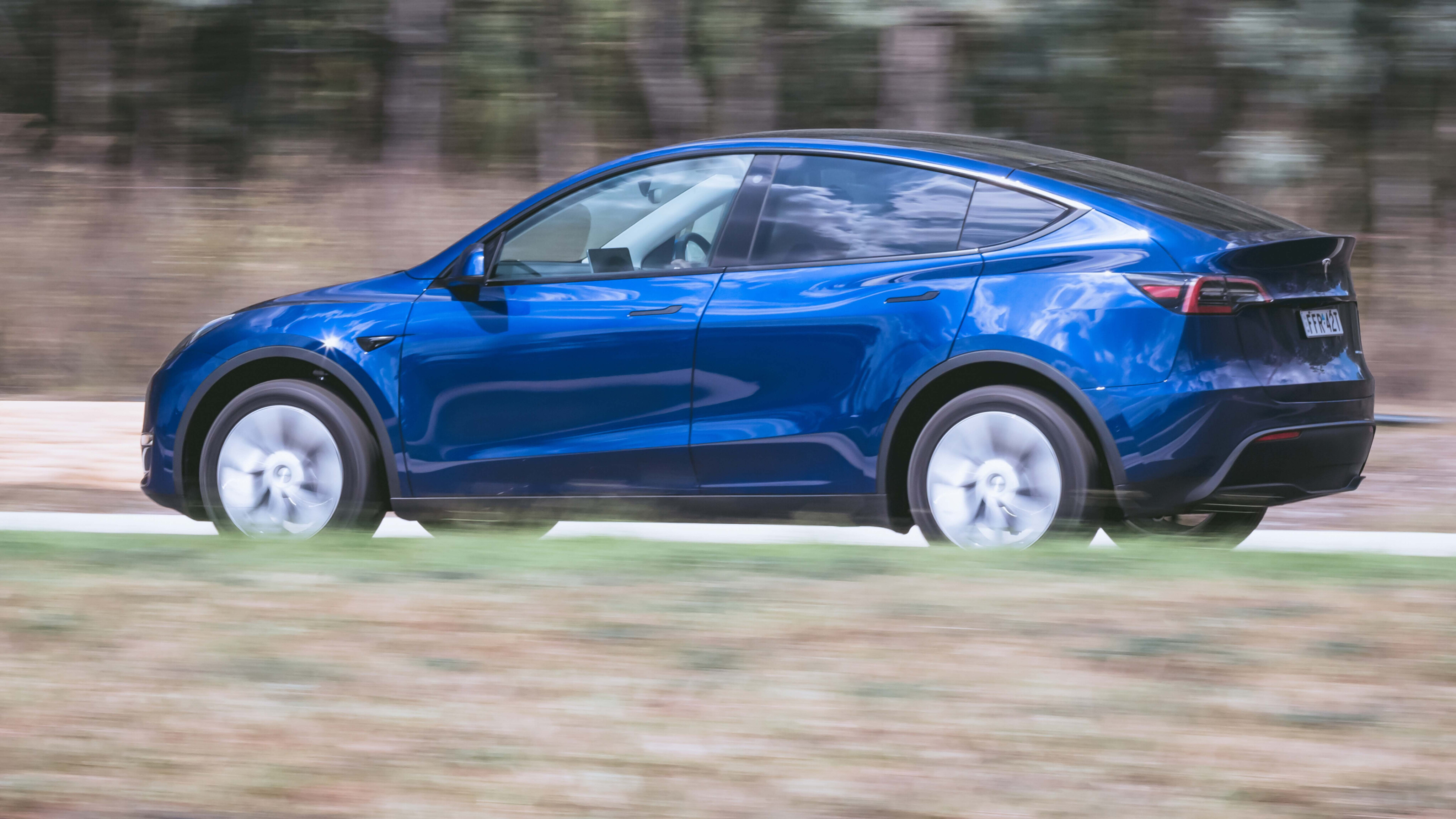
It’s also non-ventilated and unperforated vinyl, so expect to suffer some form of builder’s crack on baking summer days.
There’s more matte-white on the dash and door trims – which also feature Alcantara inserts – and, just to brighten up the place, that massive glass roof (which also does a fine job of heating up the cabin).
A three-position backrest, a flat floor and central air-con outlets feature in the spacious second-row, with a huge cargo bay behind – accessed through a generous aperture – featuring a shallow loading lip and an Esky-sized bin beneath. There’s also a 117-litre front boot.
Driving the Model Y is as easy as tapping your key card behind the console cupholders, then selecting Drive using the column stalk (now gone from the updated Model 3 sedan twin) while pressing the brake. The Tesla conquers city driving effortlessly, though its fixed-rate regen is overly draggy for some tastes and its low-speed ride is often busy – and noisy.
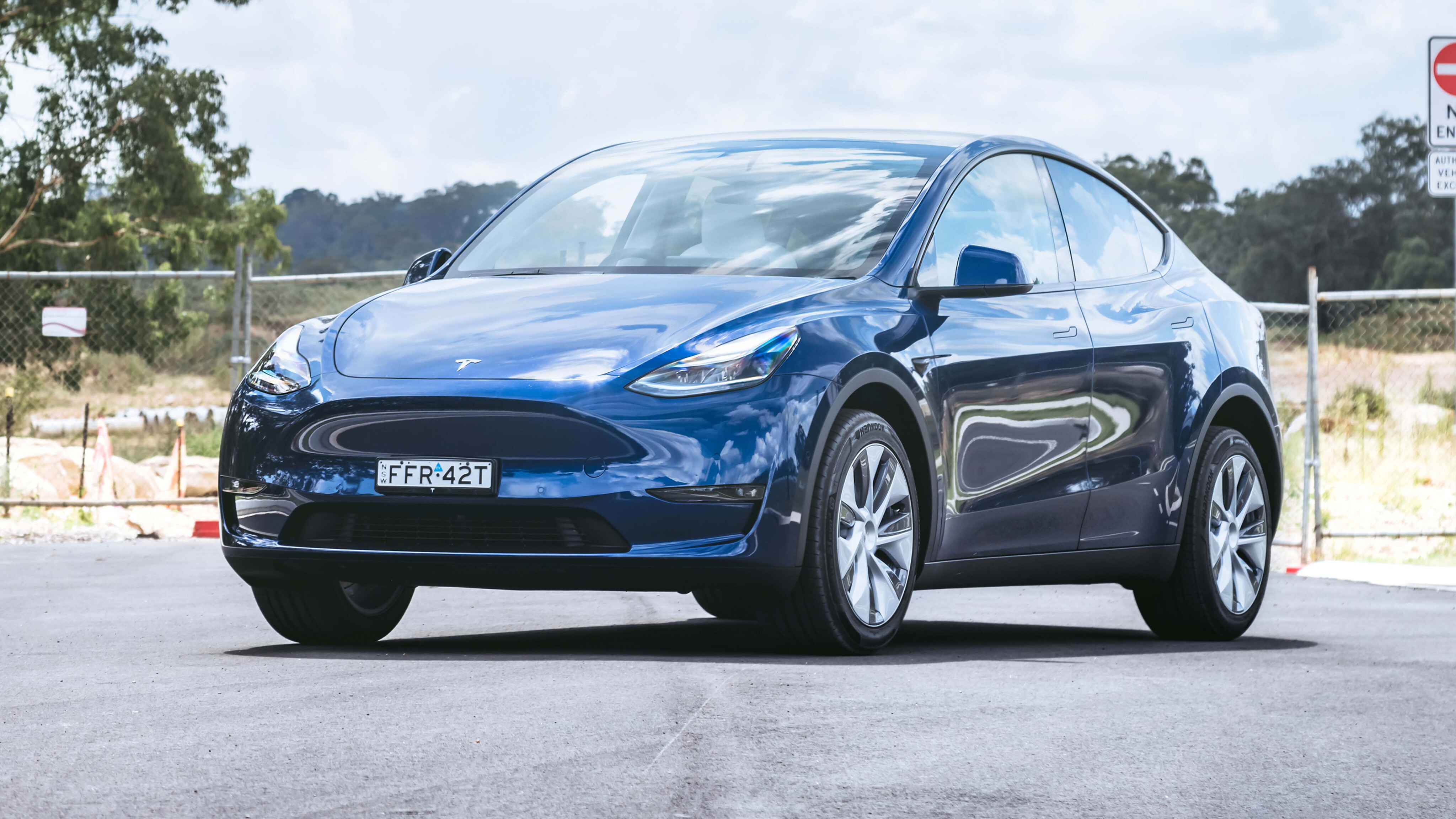
At suburban speeds, the Model Y’s poise, grip, and quick, crisp steering satisfy. It carries these qualities into its back-road behaviour while confidently despatching all but the biggest hits, which ruffle the chassis’ composure.
Like them or not, the most potent EVs have twin-turbo-V8-grade torque, and shifting the Tesla from 60km/h to 110 simply requires a brief stretch of your right foot’s toes. It’s impressive performance.
Yet Tesla’s attempt to simultaneously status signal and virtue signal surely violates one of the fundamental laws of nature.
If its popularity is any guide, the Tesla Model Y is the height of automotive fashion. It’s not, however – it’s merely a reminder that we are herd animals. I mean, how else do you explain why 28,769 buyers last year overlooked cooler and more polished alternatives to choose this stylistic nod to the Little Tykes Cozy Coupe?
James Whitbourn

Kia EV6 GT-Line
2022 COTY winner proves it still has what it takes
If Toyota and Subaru completed their joint EV development via the path of least resistance, then Kia and Hyundai have shown us with the EV6 and Ioniq 5 what’s possible when the approach is both holistic and comprehensive.
Admittedly, both brands are wholly owned by the Hyundai Motor Company (rather than being co-conspirators like Toyota and Subaru), yet considering their shared development and EV underpinnings, these twins-under-the-skin are surprisingly different in their personalities – certainly in the areas that you can see, touch and feel.
What sets the EV6 apart, however – both from its close Hyundai relative and its main competitors – is the consistency of its all-round abilities. It’s a pertinent reminder as to how the Kia EV6 range managed to score a Wheels COTY win in 2022.
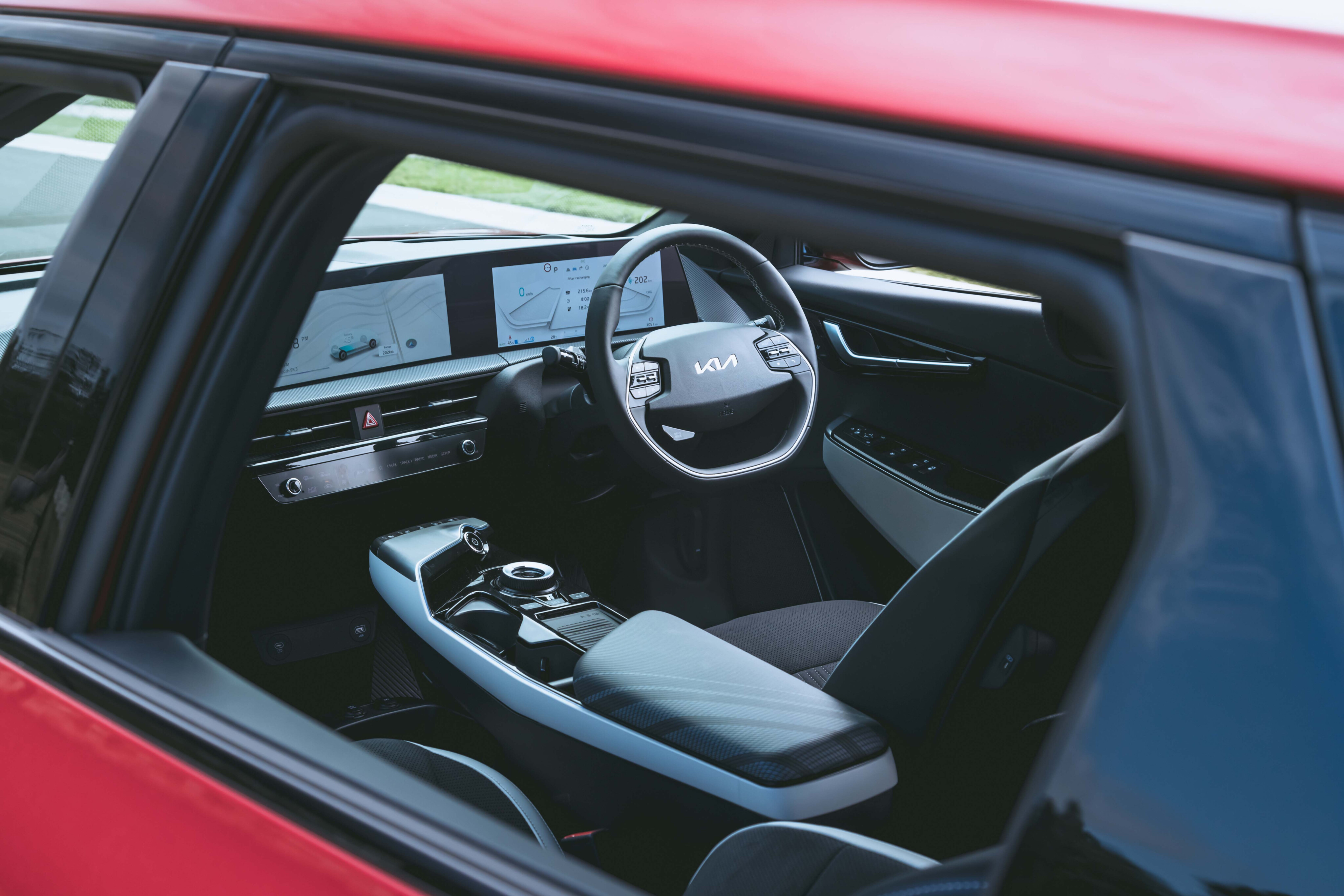
Our test EV6 GT-Line RWD ($79,590) cedes quite a bit of output muscle to the Ioniq 5 Epiq AWD ($84,000), though our intention was to show the two different flavours available in both vehicles – each with their own personality traits and drivetrain benefits.
There’s no doubt the 168kW/350Nm rear-drive EV6 GT-Line feels slower and less grippy than the 239kW/605Nm Ioniq 5 AWD, but with its superb chassis balance and decent 7.3sec 0-100km/h time, the mid-spec EV6 still has loads to recommend it when it comes to dynamic ability and driver reward.
Indeed, the rear-drive GT-Line feels quicker than its acceleration claim suggests, and given its rear-drive foundation (rather than being front-biased like the Toyobarus), it’s also better at putting its power down – especially if you disable traction control with a quick stab of its ESC button (while retaining all the safety benefits of its stability system) when attempting to tame a twisty road. Think of it as an ESC Sport calibration.
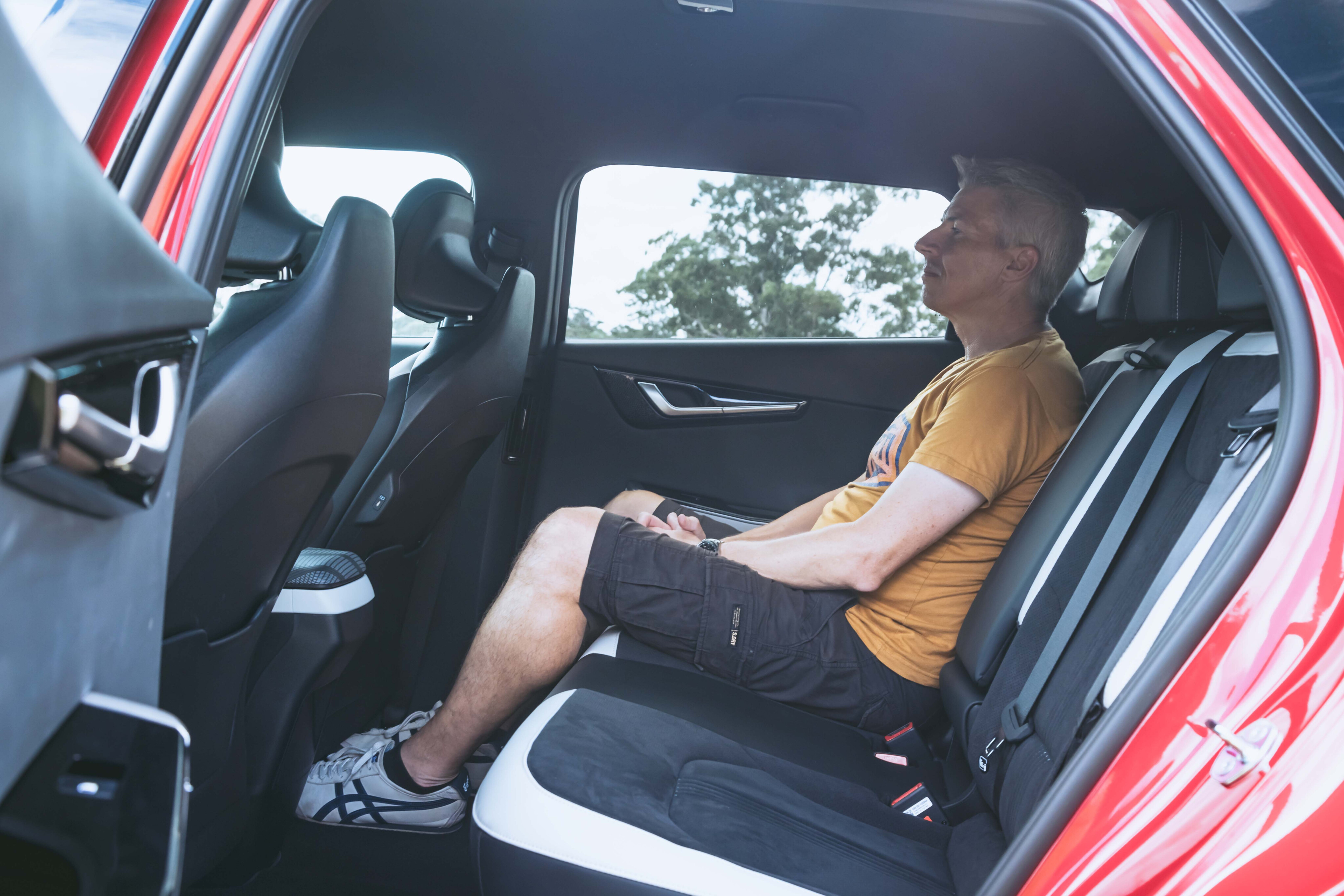
Doing so lets the EV6 breathe in corners, with delightful adjustability from its rear end combined with subtle tweaking from its ESC system. Handling is excellent and steering response is measured yet precise.
But what underpins these admirable qualities is the EV6’s terrific ride – easily the quietest, best-controlled and most serene of this bunch. And because the EV6 is so adept at absorbing what’s raging beneath, it can be driven with calming confidence on virtually any surface without disturbing its occupants.
About the only downsides are tyre squeal when pushed in tighter corners (this is a 2000kg car wearing comfort-biased 255/45R20 Continental Premium Contact 6 tyres) and ESC intrusion if you don’t switch it to the half-way point, though if either of these is a concern, there’s always the $87,590
GT-Line AWD with its Ioniq 5 AWD-matching outputs, 5.2sec 0-100km/h time, and the cabin-brightening benefits of a large electric glass sunroof.
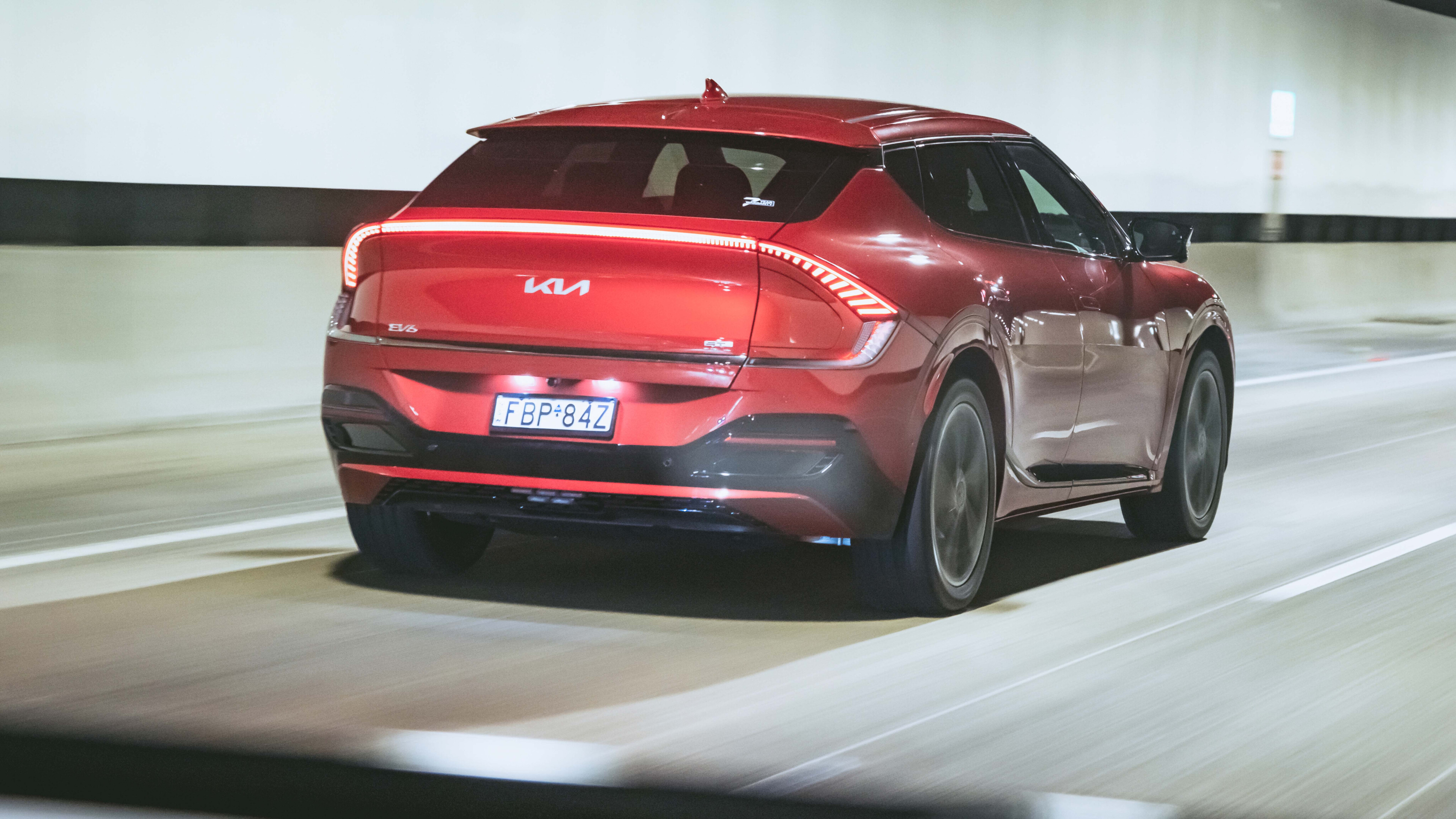
That last feature could come in handy because the rear-drive GT-Line’s all-black interior is very dark.
Spacious and comfortable, yes, but also a bit like falling down a well. When you’re seated up front, hugged by superb heated and ventilated buckets with perforated mock-suede upholstery, it’s not such an issue, but back-seat passengers might appreciate a bit less visual heaviness in their lives.
In this area, the EV6 is the opposite of the light-and-bright Ioniq 5.
The Kia also misses out on the Hyundai’s interesting cabin materials – instead favouring a far more traditional (meaning less expensive) approach.
But it compensates with its intelligent, ergonomic switchgear placement, its curved twin 12.3-inch screens, and its all-round ease of use (such as placing the wireless charging pad high and close to the driver, mounting its drive-mode button on the steering wheel, and perhaps even its conventional gear-selector dial).
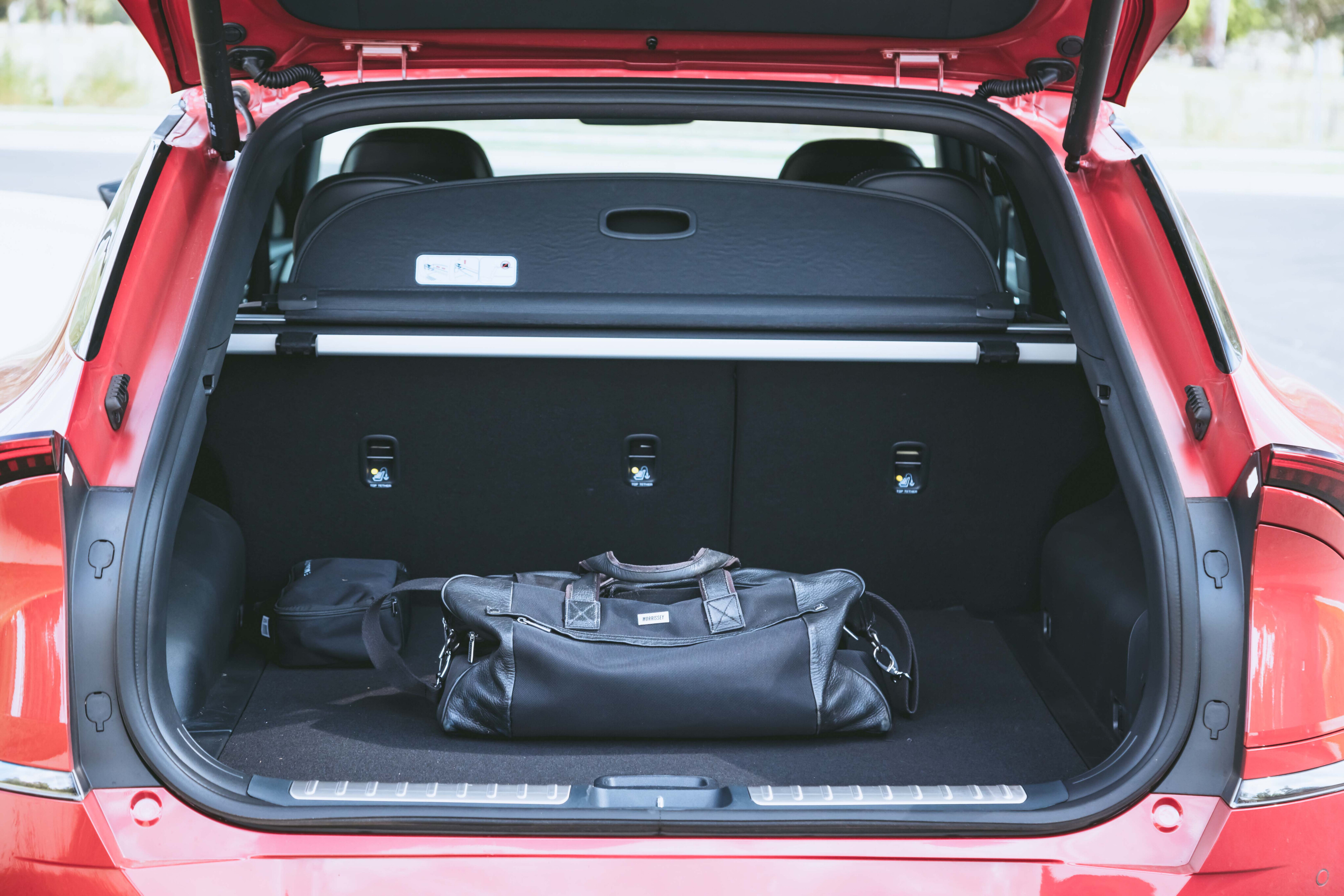
The Kia’s 14-speaker Meridian stereo is also superior to the Hyundai’s disappointing Bose, though both are comprehensively blasted by the Tesla’s ear-splitting audio, as well as the JBL and Harmon Kardon systems in the Toyota and Subaru.
As for charging and all-round efficiency, nothing can match the Kia’s 10-80 percent charge time of just 18 minutes … except for the Hyundai. And on test, the EV6’s 18.2kWh/100km consumption and 407km real-world range placed it comfortably third – neatly between the second-place Tesla and the Hyundai in fourth.
Kia’s WLTP claim is 504km for the GT-Line rear-drive and 484km for the AWD.
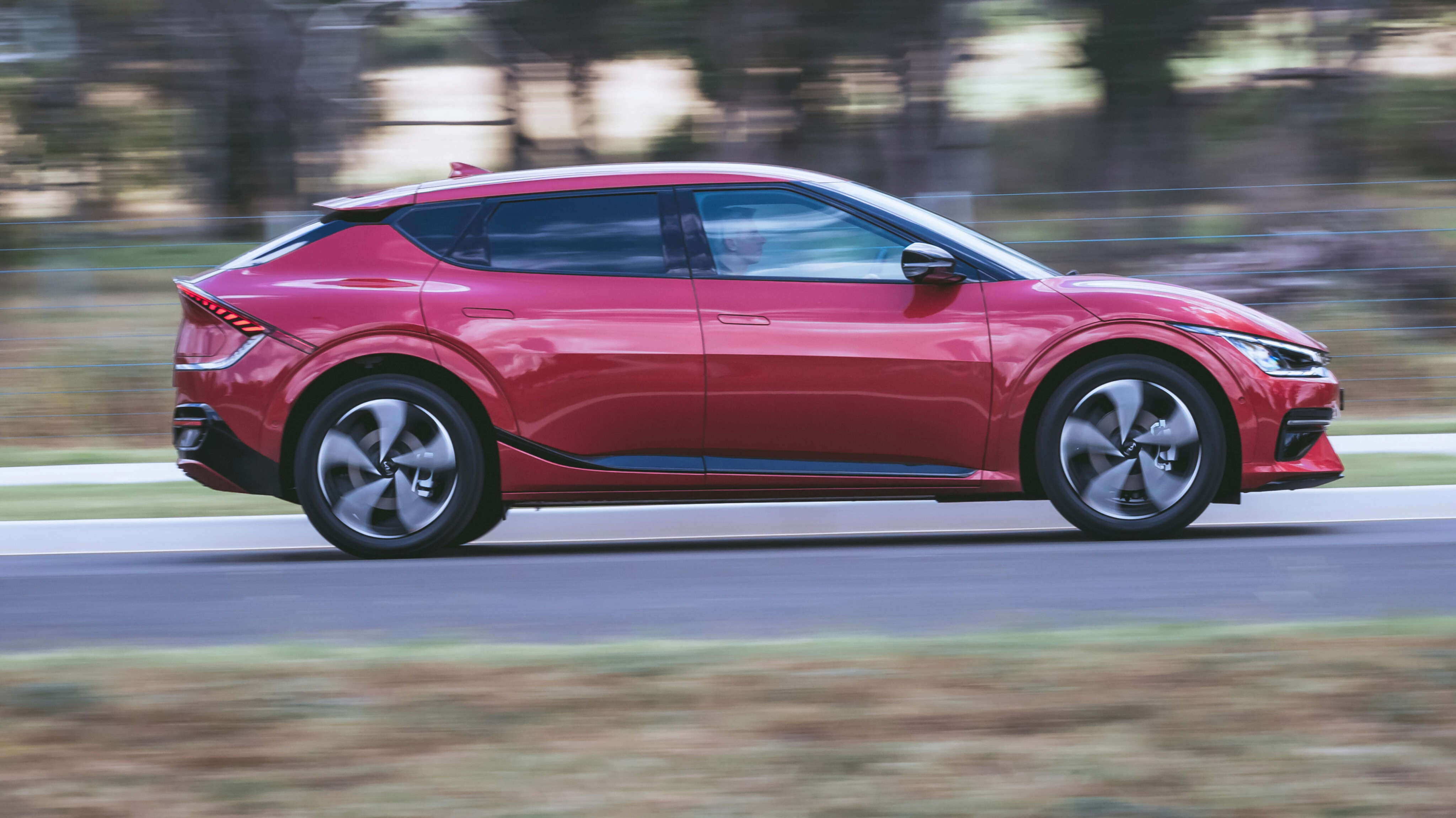
Yet the most difficult aspect in assessing the EV6 was trying to come up with negatives for its plus-and-minus panel.
Some people may not appreciate its sombre cabin environment, but at least its climate control works quite well and there’s ambient lighting in 64 colours!
Others may find it a little dated in appearance compared to Kia’s latest design heros (such as EV9 and the forthcoming EV5), though you can hardly criticise the EV6’s distinctive, coupe-like shape, which fails to have any impact on its impressive packaging efficiency.
The EV6 has arguably taken a back seat to the more high-design Hyundai Ioniq 5 in terms of both media attention and design praise, but that takes nothing away from this electric vehicle’s immense breadth of ability. In avoiding both the highs and lows of its medium EV rivals, the Kia EV6 GT-Line quietly and satisfyingly proves that the loudest voice isn’t always the smartest.
Nathan Ponchard

Winner
Difficult-to-fault Kia slays its rivals with consistency
Given that they cost between $75-87K before on-road costs, it’s reassuring to know that none of these EVs are duds. But three of the six could be categorised as disappointing.
The Ford Mustang Mach-E Premium brings up the rear, despite the electric Pony Car’s benchmark range and impressive efficiency. It’s sluggish off the line, unrefined at times, surprisingly unresolved in its dynamics, and underdone when it comes to cabin materials and thoughtful design.
In global terms, it’s already an old car – unveiled in 2019 in the US – so as Ford Australia’s great new EV hope, it falls some way short of where it needs to be in 2024.

Despite the Toyota and Subaru’s relative lack of range, they beat the Mach-E because of their consistency.
They do most things quite well but nothing with any degree of distinction or panache, which unfortunately reminds us of the mediocrity of older-generation Toyotas – not the slick, classy, polished feel that has defined more recent attempts such as RAV4 and Corolla. For a new-from-the-ground-up design, they don’t feel like it.

That leaves the Hyundai Ioniq 5 Epiq AWD, the Kia EV6 GT-Line and the Tesla Model Y Long Range.
The Hyundai is by far the coolest EV here – its design transcends its price and brand image like few cars in history – and its charging technology, drivetrain performance and outright acceleration and grip are all stupendous. But its lolling ride quality impinges on its otherwise-terrific handling and driving character.
The Tesla is the opposite. Chunky hips and classy frameless doors aside, its design is so unspectacular that if you were searching for what a generic ‘car’ looked like, it would probably be a Model Y (or a Model 3).
Its hot, reflective cabin struggles in summer weather and its wilfully different control layout takes some getting used to … but its packaging is brilliant, its steering and handling are infectious, and its all-round entertainment factor is huge. Sealing the deal is its outstanding stereo – easily the best here – as well as Tesla’s comprehensive fast-charging network.

The EV6 GT-Line is a more cohesive car. Like the Tesla, not everyone loves the way it looks, but at least it’s distinctive. And the more you ask of it, the better this Kia gets.
Sure, the rear-drive EV6 lacks the AWD version’s corner-exit thrust and grip, but it offers plenty of punch, is still highly entertaining in corners, and is undoubtedly the best-riding, most refined, most comfortable and most resolved EV of this sextet.
It brings the latest 800-volt EV technology to the table, yet it doesn’t cost the earth, and it’s covered by the longest warranty.
Again, it’s not perfect, but as a likeable, characterful, genuinely useful medium-sized family EV, the EV6 is yet to be surpassed.
Specifications
| Ford Mustang Mach-E specifications | Subaru Solterra | Toyota bZ4x | Hyundai Ioniq 5 Epiq AWD | Tesla Model Y | Kia EV6 GT-Line | |
|---|---|---|---|---|---|---|
| Motor | Rear-mounted permanent magnet synchronous | Front- and rear-mounted permanent magnet synchronous | Front- and rear-mounted permanent magnet synchronous | Front- and rear-mounted permanent magnet synchronous | Front- and rear-mounted permanent magnet synchronous | Rear-mounted permanent magnet synchronous |
| Max power | 216kW | 160kW | 160kW | 239kW | 286kW | 168kW |
| Max torque | 430Nm | 337Nm | 337Nm | 605Nm | 510Nm | 350Nm |
| L/W/H/W-B | 4728/1881/1634/ 2984mm | 4690/1860/1650/2850mm | 4690/1860/1650/2850mm | 4635/1890/1605/ 3000mm | 4751/1921/1624/ 2890mm | 4695/1890/1550/ 2900mm |
| Cargo space | 402-1420 + 134L | 410-n/aL | 410-n/aL | 527-1587 + 24L | 854-2041 + 117L | 480-1260 + 52L |
| Weight | 2098kg | 2060kg | 2055kg | 2125kg | 1979kg | 2000kg |
| 0-100km/h (claimed) | 6.2sec | 6.9sec | 6.9sec | 5.2sec | 5.0sec | 7.3sec |
| Battery size (usable) | 91.0kWh | 64.0kWh | 64.0kWh | 74.0kWh | 75.0kWh | 74.0kWh |
| Consumption (tested) | 18.0kWh/100km | 18.5kWh/100km | 18.6kWh/100km | 18.9kWh/100km | 17.7kWh/100km | 18.2kWh/100km |
| Driving range (WLTP/tested) | 600km / 506km | 411km / 346km | 411km / 344km | 454km / 392km | 533km / 424km | 504km / 407km |
| DC fast charge | 150kW / 45 minutes | 150kW / 30 minutes | 150kW / 30 minutes | 233kW / 18 minutes | 250kW / 27 minutes | 240kW / 18 minutes |
| ANCAP | 5 stars (2021) | 5 stars (2022) | 5 stars (2022) | 5 stars (2021) | 5 stars (2022) | 5 stars (2022) |
| Price | $86,990 | $76,990 | $74,900 | $84,000 | $78,400 | $79,590 |
| SCORE | 6.0/10 | 6.5/10 | 6.5/10 | 8.0/10 | 8.0/10 | 8.5/10 |
Medium electric SUVs: tested efficiency
| Vehicle | Battery | WLTP Best* | WLTP Worst* | WLTP Quoted | On-test Efficiency | RW Range | Functional Range |
|---|---|---|---|---|---|---|---|
| Mustang Mach-E | 91.0kWh | 600km | n/a | 600km | 18.0kWh/100km | 506km | 354km |
| Model Y LR | 75.0kWh* | 542km | 533km | 533km | 17.7kWh/100km | 424km | 297km |
| EV6 RWD | 74.0kWh | 528km | 504km | 504km | 18.2kWh/100km | 407km | 285km |
| lonia 5 AWD | 74.0kWh | 481km | 454km | 454km | 18.9kWh/100km | 392km | 274km |
| Solterra | 64.0kWh | 466km | 416km | not quoted | 18.5kWh/100km | 346km | 242km |
| bZ4X | 64.0kWh | 461km | 415km | 411km | 18.6kWh/100km | 344km | 241km |
⚡ 2024 Wheels Best EVs
Looking for an EV in a different size or price category? Visit our full Wheels Best EVs series at the links below.
🔗 Wheels Best EVs
- Best Small Electric Car Under $40K
- Best Small Electric Car $40-50K
- Best Small Electric Car $50-60K
- Best Electric Small SUV
- Best Electric Midsize SUV
- Best Electric Midsize Sedan
🏅 OVERALL WINNER: Best Electric Car Under $80K
COMING SOON
- Best Electric Large SUV
- Best Electric Small Luxury SUV
- Best Electric Midsize Luxury SUV
- Best Electric Luxury Sedan Under $100K
- Best Electric Luxury Sedan Over $100K
- Best Electric Performance Car

COMMENTS